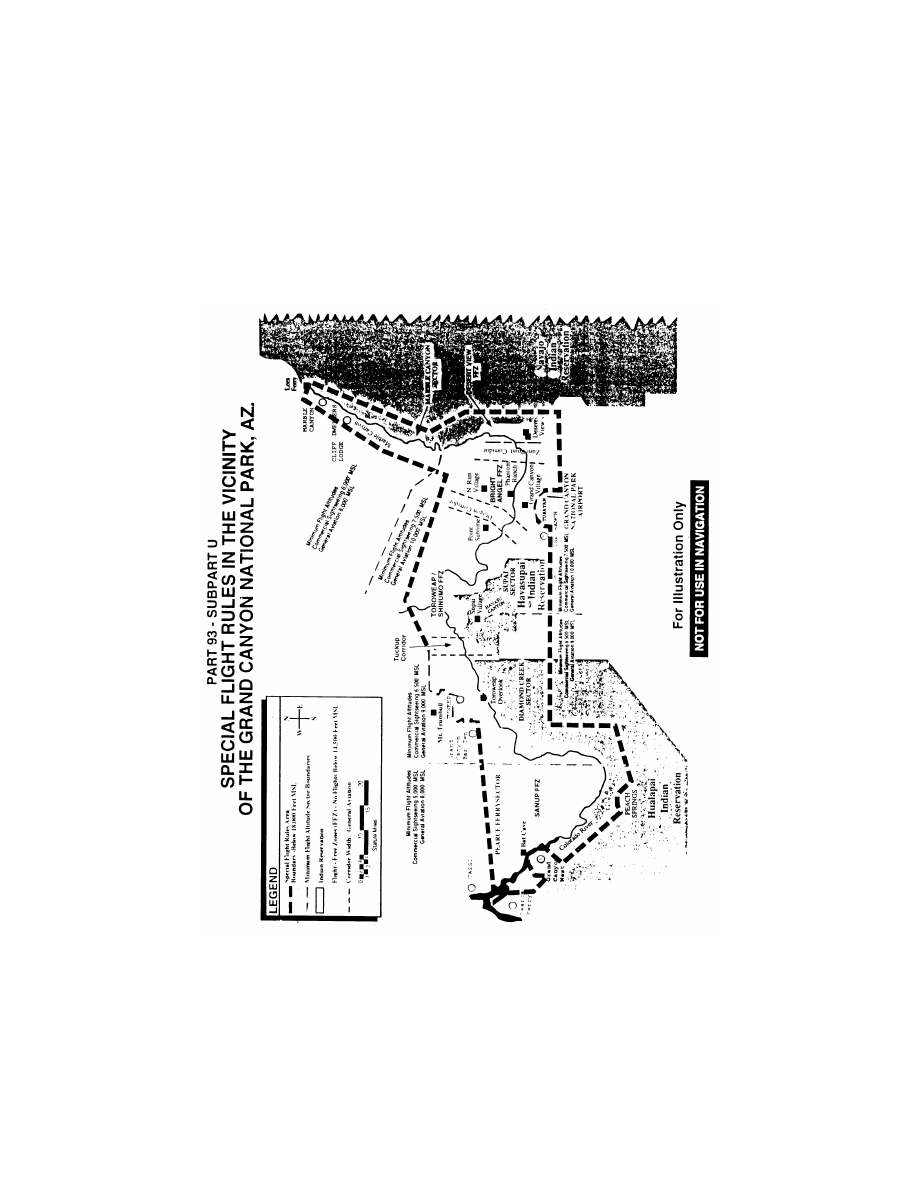
838
14 CFR Ch. I (1–1–24 Edition)
Pt. 93
(3) An altitude alert system that signals an
alert when the altitude displayed to the
flightcrew deviates from the selected alti-
tude by more than—
(i)
±
300 feet for aircraft for which applica-
tion for type certification was made on or
before April 9, 1997; or
(ii)
±
200 feet for aircraft for which applica-
tion for type certification is made after
April 9, 1997.
(4) A TCAS II that meets TSO C–119b
(Version 7.0), or a later version, if equipped
with TCAS II, unless otherwise authorized
by the Administrator.
(5) Unless authorized by ATC or the foreign
country where the aircraft is operated, an
ADS–B Out system that meets the equip-
ment performance requirements of § 91.227 of
this part. The aircraft must have its height-
keeping performance monitored in a form
and manner acceptable to the Administrator.
(b) The altimetry system error (ASE) of
the aircraft does not exceed 200 feet when op-
erating in RVSM airspace.
[Doc. No. 28870, 62 FR 17487, Apr. 9, 1997, as
amended by Amdt. 91–261, 65 FR 5942, Feb. 7,
2000; Amdt. 91–271, 66 FR 63895, Dec. 10, 2001;
Amdt. 91–274, 68 FR 54584, Sept. 17, 2003;
Amdt. 91–276, 68 FR 70133, Dec. 17, 2003; Dock-
et FAA–2015–1746, Amdt. 91–342, 81 FR 47017,
July 20, 2016; Docket FAA–2016–9154, Amdt.
91–348, 82 FR 39664, Aug. 22, 2017; FAA-2017-
0782, Amdt. No. 91-354, 83 FR 65492, Dec. 21,
2018]
PART 93—SPECIAL AIR TRAFFIC
RULES
S
PECIAL
F
EDERAL
A
VIATION
R
EGULATION
N
O
.
60 [N
OTE
]
Subpart A—General
Sec.
93.1
Applicability.
Subparts B–C
[
Reserved
]
Subpart D—Anchorage, Alaska, Terminal
Area
93.51
Applicability.
93.53
Description of area.
93.55
Subdivision of Terminal Area.
93.57
General rules: All segments.
93.59
General rules: International segment.
93.61
General rules: Lake Hood segment.
93.63
General rules: Merrill segment.
93.65
General rules: Elmendorf segment.
93.67
General rules: Bryant segment.
93.68
General rules: Seward Highway seg-
ment.
93.69
Special requirements, Lake Campbell
and Sixmile Lake Airports.
Subpart E—Flight Restrictions in the Vicinity
of Niagara Falls, New York
93.71
General operating procedures.
Subpart F—Valparaiso, Florida, Terminal
Area
93.80
Applicability.
93.81
Applicability and description of area.
93.83
Aircraft operations.
Subpart G—Special Flight Rules in the
Vicinity of Los Angeles International Airport
93.91
Applicability.
93.93
Description of area.
93.95
General operating procedures.
93.97
Operations in the SFRA.
Subpart H—Mandatory Use of the New
York North Shore Helicopter Route
93.101
Applicability
93.103
Helicopter operations.
Subpart I
[
Reserved
]
Subpart J—Lorain County Regional Airport
Traffic Rule
93.117
Applicability.
93.119
Aircraft operations.
Subpart K—High Density Traffic Airports
93.121
Applicability.
93.123
High density traffic airports.
93.125
Arrival or departure reservation.
93.129
Additional operations.
93.130
Suspension of allocations.
93.133
Exceptions.
Subpart L
[
Reserved
]
Subpart M—Ketchikan International Airport
Traffic Rule
93.151
Applicability.
93.152
Description of area.
93.153
Communications.
93.155
Aircraft operations.
Subpart N—Pearson Field (Vancouver, WA)
Airport Traffic Rule
93.161
Applicability.
93.162
Description of area.
93.163
Aircraft operations.
Subpart O—Special Flight Rules in the
Vicinity of Luke AFB, AZ
93.175
Applicability.
93.176
Description of area.
93.177
Operations in the Special Air Traffic
Rule Area.
VerDate Sep<11>2014
14:00 Mar 14, 2024
Jkt 262047
PO 00000
Frm 00848
Fmt 8010
Sfmt 8006
Q:\14\14V2.TXT
PC31
aworley on LAPBH6H6L3 with DISTILLER

839
Federal Aviation Administration, DOT
§ 93.51
Subparts P–R
[
Reserved
]
Subpart S—Allocation of Commuter and
Air Carrier IFR Operations at High Den-
sity Traffic Airports
93.211
Applicability.
93.213
Definitions and general provisions.
93.215
Initial allocation of slots.
93.217
Allocation of slots for international
operations and applicable limitations.
93.218
Slots for transborder service to and
from Canada.
93.219
Allocation of slots for essential air
service operations and applicable limita-
tions.
93.221
Transfer of slots.
93.223
Slot withdrawal.
93.224
Return of slots.
93.225
Lottery of available slots.
93.226
Allocation of slots in low-demand pe-
riods.
93.227
Slot use and loss.
Subpart T—Ronald Reagan Washington
National Airport Traffic Rules
93.251
Applicability.
93.253
Nonstop operations.
Subpart U—Special Flight Rules in the Vi-
cinity of Grand Canyon National Park,
AZ
93.301
Applicability.
93.303
Definitions.
93.305
Flight-free zones and flight corridors.
93.307
Minimum flight altitudes.
93.309
General operating procedures.
93.311
Minimum terrain clearance.
93.313
Communications.
93.315
Requirements for commercial Special
Flight Rules Area operations.
93.316
[Reserved]
93.317
Commercial Special Flight Rules
Area operation curfew.
93.319
Commercial air tour limitations.
93.321
Transfer and termination of alloca-
tions.
93.323
[Reserved]
93.325
Quarterly reporting.
A
PPENDIX TO
S
UBPART
U
OF
P
ART
93—S
PECIAL
F
LIGHT
R
ULES
IN
THE
V
ICINITY
OF
THE
G
RAND
C
ANYON
N
ATIONAL
P
ARK
, AZ
A
PPENDIX
A
TO
S
UBPART
U
OF
P
ART
93—
GCNP Q
UIET
A
IRCRAFT
T
ECHNOLOGY
D
ES
-
IGNATION
Subpart V—Washington, DC Metropolitan
Area Special Flight Rules Area
93.331
Purpose and applicability of this sub-
part.
93.333
Failure to comply with this subpart.
93.335
Definitions.
93.337
Requirements for operating in the DC
SFRA.
93.339
Requirements for operating in the DC
SFRA, including the DC FRZ.
93.341
Aircraft operations in the DC FRZ.
93.343
Requirements for aircraft operations
to or from College Park Airport, Poto-
mac Airfield, or Washington Executive/
Hyde Field Airport.
93.345
VFR outbound procedures for fringe
airports.
Subpart W—New York Class B Airspace
Hudson River and East River Exclusion
Special Flight Rules Area
93.350
Definitions.
93.351
General requirements for operating in
the East River and/or Hudson River Ex-
clusions.
93.352
Hudson River Exclusion specific oper-
ating procedures.
93.353
East River Exclusion specific oper-
ating procedures.
A
UTHORITY
: 49 U.S.C. 106(f), 106(g), 40103,
40106, 40109, 40113, 44502, 44514, 44701, 44715,
44719, 46301.
S
PECIAL
F
EDERAL
A
VIATION
R
EGULATION
N
O
. 60
E
DITORIAL
N
OTE
: For the text of SFAR No.
60, see part 91 of this chapter.
Subpart A—General
§ 93.1
Applicability.
This part prescribes special air traf-
fic rules for operating aircraft in cer-
tain areas described in this part, unless
otherwise authorized by air traffic con-
trol.
[Doc. No. FAA–2002–13235, 68 FR 9795, Feb. 28,
2003]
Subparts B–C
[
Reserved
]
Subpart D—Anchorage, Alaska,
Terminal Area
S
OURCE
: Docket No. 29029, 64 FR 14976, Mar.
29, 1999, unless otherwise noted.
§ 93.51
Applicability.
This subpart prescribes special air
traffic rules for aircraft operating in
the Anchorage, Alaska, Terminal Area.
[Doc. No. FAA–2002–13235, 68 FR 9795, Feb. 28,
2003]
VerDate Sep<11>2014
14:00 Mar 14, 2024
Jkt 262047
PO 00000
Frm 00849
Fmt 8010
Sfmt 8010
Q:\14\14V2.TXT
PC31
aworley on LAPBH6H6L3 with DISTILLER

840
14 CFR Ch. I (1–1–24 Edition)
§ 93.53
§ 93.53
Description of area.
The Anchorage, Alaska, Terminal
Area is designated as that airspace ex-
tending upward from the surface to the
upper limit of each of the segments de-
scribed in § 93.55. It is bounded by a line
beginning at Point MacKenzie, extend-
ing westerly along the bank of Knik
Arm to a point intersecting the 350
°
bearing from the Anchorage Inter-
national ATCT; thence north to inter-
cept the 5.2-mile arc centered on the
geographical center of Anchorage,
Alaska, ATCT; thence counter-
clockwise along that arc to its inter-
section with a line bearing 180
°
from
the intersection of the new Seward
Highway and International Airport
Road; thence due north to O’Malley
Road; thence east along O’Malley Road
to its intersection with Lake Otis
Parkway; thence northerly along Lake
Otis Parkway to its intersection with
Abbott Road; thence east along Abbott
Road to its intersection with Abbott
Loop Road; thence north to its inter-
section with Tudor Road; thence eas-
terly along Tudor Road to its intersec-
tion with Muldoon Road; thence north-
erly along Muldoon Road to the inter-
section of the Glenn Highway; thence
north and east along the Glenn High-
way to Ski Bowl Road; thence south-
east along the Ski Bowl Road to a
point one-half mile south of the Glenn
Highway; thence north and east one-
half mile south of and parallel to the
Glenn Highway to its intersection with
a line one-half mile east of and parallel
to the Bryant Airport Runway 16/34 ex-
tended centerline; thence northeast
along a line one-half mile east of and
parallel to Bryant Airport Runway 16/
34 extended centerline to lat. 61
°
17
′
13
″
N., long. 149
°
37
′
35
″
W.; thence west
along lat. 61
°
17
′
13
″
N., to long. 149
°
43
′
08
″
W.; thence north along long. 149
°
43
′
08
″
W., to lat. 61
°
17
′
30
″
N.; thence to lat.
61
°
17
′
58
″
N., long 149
°
44
′
08
″
W.; thence to
lat. 61
°
19
′
10
″
N., long. 149
°
46
′
44
″
W.;
thence north along long. 149
°
46
′
44
″
W.,
to intercept the 4.7-mile radius arc cen-
tered on Elmendorf Air Force Base
(AFB), Alaska; thence counter-
clockwise along the 4.7-mile radius arc
to its intersection with the west bank
of Knik Arm; thence southerly along
the west bank of Knik Arm to the
point of beginning.
[Doc. No. 29029, 64 FR 14976, Mar. 29, 1999;
Amdt. 93–77, 64 FR 17439, Apr. 9, 1999]
§ 93.55
Subdivision of Terminal Area.
The Anchorage, Alaska, Terminal
Area is subdivided as follows:
(a)
International segment. That area
from the surface to and including 4,100
feet MSL, within a 5.2-mile radius of
the Anchorage International ATCT; ex-
cluding that airspace east of the 350
°
bearing from the Anchorage Inter-
national ATCT and north of the 090
°
bearing from the Anchorage Inter-
national ATCT and east of a line bear-
ing 180
°
and 360
°
from the intersection
of the new Seward Highway and Inter-
national Airport Road and the airspace
extending upward from the surface to
but not including 600 feet MSL, south
of lat. 61
°
08
′
28
″
N.
(b)
Merrill segment. That area from
the surface to and including 2,500 feet
MSL, within a line beginning at Point
Noname; thence direct to the mouth of
Ship Creek; thence direct to the inter-
section of the Glenn Highway and
Muldoon Road; thence south along
Muldoon Road to Tudor Road; thence
west along Tudor Road to the new Sew-
ard Highway; thence direct to West An-
chorage High School; thence direct to
Point MacKenzie; thence via the north
bank of Knik Arm to the point of be-
ginning.
(c)
Lake Hood segment. That area from
the surface to and including 2,500 feet
MSL, within a line beginning at Point
MacKenzie; thence direct to West An-
chorage High School; thence direct to
the intersection of Tudor Road and the
new Seward Highway; thence south
along the new Seward Highway to the
090
°
bearing from the Anchorage Inter-
national ATCT; thence west direct to
the Anchorage International ATCT;
thence north along the 350
°
bearing
from the Anchorage International
ATCT to the north bank of Knik arm;
thence via the north bank of Knik Arm
to the point of beginning.
(d)
Elmendorf segment. That area from
the surface to and including 3,000 feet
MSL, within a line beginning at Point
Noname; thence via the north bank of
Knik Arm to the intersection of the
4.7-mile radius of Elmendorf AFB;
VerDate Sep<11>2014
14:00 Mar 14, 2024
Jkt 262047
PO 00000
Frm 00850
Fmt 8010
Sfmt 8010
Q:\14\14V2.TXT
PC31
aworley on LAPBH6H6L3 with DISTILLER

841
Federal Aviation Administration, DOT
§ 93.59
thence clockwise along the 4.7-mile ra-
dius of Elmendorf AFB to long.
149
°
46
′
44
″
W.; thence south along long.
149
°
46
′
44
″
W. to lat. 61
°
19
′
10
″
N.; thence
to lat. 61
°
17
′
58
″
N., long. 149
°
44
′
08
″
W.;
thence to lat. 61
°
17
′
30
″
N., long.
149
°
43
′
08
″
W.; thence south along long.
149
°
43
′
08
″
W. to the Glenn Highway;
thence south and west along the Glenn
Highway to Muldoon Road; thence di-
rect to the mouth of Ship Creek;
thence direct to the point of beginning.
(e)
Bryant segment. That area from
the surface to and including 2,000 feet
MSL, within a line beginning at lat.
61
°
17
′
13
″
N., long. 149
°
37
′
35
″
W.; thence
west along lat. 61
°
17
′
13
″
N., to long.
149
°
43
′
08
″
W.; thence south along long.
149
°
43
′
08
″
W., to the Glenn Highway;
thence north and east along the Glenn
Highway to Ski Bowl Road; thence
southeast along the Ski Bowl Road to
a point one-half mile south of the
Glenn Highway; thence north and east
one-half mile south of and parallel to
the Glenn Highway to its intersection
with a line one-half mile east of and
parallel to the Bryant Airport Runway
16/34 extended centerline; thence north-
east along a line one-half mile east of
and parallel to Bryant Airport runway
16/34 extended centerline to the point of
beginning.
(f)
Seward Highway segment. That
area from the surface to and including
4,100 feet MSL, within a line beginning
at the intersection of a line bearing
180
°
from the intersection of the new
Seward Highway and International Air-
port Road, and O’Malley Road; thence
east along O’Malley Road to its inter-
section with Lake Otis Park Way, lat.
61
°
07
′
23
″
N., long 149
°
50
′
03
″
W.; thence
northerly along Lake Otis Park Way to
its intersection with Abbott Road, lat.
61
°
08
′
14
″
N., long. 149
°
50
′
03
″
W.; thence
east along Abbott Road to its intersec-
tion with Abbott Loop Road, lat.
61
°
08
′
14
″
N., long. 149
°
48
′
16
″
W.; thence
due north to intersect with Tudor
Road, lat. 61
°
10
′
51
″
N., long. 149
°
48
′
16
″
W.; thence west along Tudor Road to
its intersection with the new Seward
Highway, lat. 61
°
10
′
51
″
N., long.
149
°
51
′
38
″
W.; thence south along the
new Seward Highway to its intersec-
tion with a line bearing 180
°
and 360
°
from the intersection of the new Sew-
ard Highway and International Airport
Road; thence south to the point of be-
ginning.
[Doc. No. 29029, 64 FR 14976, Mar. 29, 1999;
Amdt. 93–77, 64 FR 17439, Apr. 9, 1999]
§ 93.57
General rules: All segments.
(a) Each person operating an aircraft
to, from, or on an airport within the
Anchorage, Alaska, Terminal Area
shall operate that aircraft according to
the rules set forth in this section and
§§ 93.59, 93.61, 93.63, 93.65, 93.67, or 93.68
as applicable, unless otherwise author-
ized or required by ATC.
(b) Each person operating an airplane
within the Anchorage, Alaska Ter-
minal Area shall conform to the flow of
traffic depicted on the appropriate
aeronautical charts.
(c) Each person operating a heli-
copter shall operate it in a manner so
as to avoid the flow of airplanes.
(d) Except as provided in § 93.65 (d)
and (e), and § 93.67(b), each person oper-
ating an aircraft in the Anchorage,
Alaska, Terminal Area shall operate
that aircraft only within the des-
ignated segment containing the arrival
or departure airport.
(e) Except as provided in §§ 93.63(d)
and 93.67(b), each person operating an
aircraft in the Anchorage, Alaska, Ter-
minal Area shall maintain two-way
radio communications with the ATCT
serving the segment containing the ar-
rival or departure airport.
§ 93.59
General rules: International
segment.
(a) No person may operate an aircraft
at an altitude between 1,200 feet MSL
and 2,000 feet MSL in that portion of
this segment lying north of the
midchannel of Knik Arm.
(b) Each person operating an airplane
at a speed of more than 105 knots with-
in this segment (except that part de-
scribed in paragraph (a) of this section)
shall operate that airplane at an alti-
tude of at least 1,600 feet MSL until
maneuvering for a safe landing requires
further descent.
(c) Each person operating an airplane
at a speed of 105 knots or less within
this segment (except that part de-
scribed in paragraph (a) of this section)
VerDate Sep<11>2014
14:00 Mar 14, 2024
Jkt 262047
PO 00000
Frm 00851
Fmt 8010
Sfmt 8010
Q:\14\14V2.TXT
PC31
aworley on LAPBH6H6L3 with DISTILLER

842
14 CFR Ch. I (1–1–24 Edition)
§ 93.61
shall operate that airplane at an alti-
tude of at least 900 feet MSL until ma-
neuvering for a safe landing requires
further descent.
§ 93.61
General rules: Lake Hood seg-
ment.
(a) No person may operate an aircraft
at an altitude between 1,200 feet MSL
and 2,000 feet MSL in that portion of
this segment lying north of the
midchannel of Knik Arm.
(b) Each person operating an airplane
within this segment (except that part
described in paragraph (a) of this sec-
tion) shall operate that airplane at an
altitude of at least 600 feet MSL until
maneuvering for a safe landing requires
further descent.
§ 93.63
General rules: Merrill segment.
(a) No person may operate an aircraft
at an altitude between 600 feet MSL
and 2,000 feet MSL in that portion of
this segment lying north of the
midchannel of Knik Arm.
(b) Each person operating an airplane
at a speed of more than 105 knots with-
in this segment (except for that part
described in paragraph (a) of this sec-
tion) shall operate that airplane at an
altitude of at least 1,200 feet MSL until
maneuvering for a safe landing requires
further descent.
(c) Each person operating an airplane
at a speed of 105 knots or less within
this segment (except for that part de-
scribed in paragraph (a) of this section)
shall operate that airplane at an alti-
tude of at least 900 feet MSL until ma-
neuvering for a safe landing requires
further descent.
(d) Whenever the Merrill ATCT is not
operating, each person operating an
aircraft either in that portion of the
Merrill segment north of midchannel of
Knik Arm, or in the Seward Highway
segment at or below 1200 feet MSL,
shall contact Anchorage Approach Con-
trol for wake turbulence and other
advisories. Aircraft operating within
the remainder of the segment should
self-announce intentions on the Merrill
Field CTAF.
§ 93.65
General rules: Elmendorf seg-
ment.
(a) Each person operating a turbine-
powered aircraft within this segment
shall operate that aircraft at an alti-
tude of at least 1,700 feet MSL until
maneuvering for a safe landing requires
further descent.
(b) Each person operating an airplane
(other than turbine-powered aircraft)
at a speed of more than 105 knots with-
in this segment shall operate that air-
plane at an altitude of at least 1,200
feet MSL until maneuvering for a safe
landing requires further descent.
(c) Each person operating an airplane
(other than turbine-powered aircraft)
at a speed of 105 knots or less within
the segment shall operate that airplane
at an altitude of at least 800 feet MSL
until maneuvering for a safe landing
requires further descent.
(d) A person landing or departing
from Elmendorf AFB, may operate that
aircraft at an altitude between 1,500
feet MSL and 1,700 feet MSL within
that portion of the International and
Lake Hood segments lying north of the
midchannel of Knik Arm.
(e) A person landing or departing
from Elmendorf AFB, may operate that
aircraft at an altitude between 900 feet
MSL and 1,700 feet MSL within that
portion of the Merrill segment lying
north of the midchannel of Knik Arm.
(f) A person operating in VFR condi-
tions, at or below 600 feet MSL, north
of a line beginning at the intersection
of Farrell Road and the long. 149
°
43
′
08
″
W.; thence west along Farrell Road to
the east end of Sixmile Lake; thence
west along a line bearing on the middle
of Lake Lorraine to the northwest
bank of Knik Arm; is not required to
establish two-way radio communica-
tions with ATC.
[Doc. No. 29029, 64 FR 14977, Mar. 29, 1999;
Amdt. 93–77, 64 FR 17439, Apr. 9, 1999]
§ 93.67
General rules: Bryant segment.
(a) Each person operating an airplane
to or from the Bryant Airport shall
conform to the flow of traffic shown on
the appropriate aeronautical charts,
and while in the traffic pattern, shall
operate that airplane at an altitude of
at least 1,000 feet MSL until maneu-
vering for a safe landing requires fur-
ther descent.
(b) Each person operating an aircraft
within the Bryant segment should self-
announce intentions on the Bryant
Airport CTAF.
VerDate Sep<11>2014
14:00 Mar 14, 2024
Jkt 262047
PO 00000
Frm 00852
Fmt 8010
Sfmt 8010
Q:\14\14V2.TXT
PC31
aworley on LAPBH6H6L3 with DISTILLER

843
Federal Aviation Administration, DOT
§ 93.71
§ 93.68
General rules: Seward Highway
segment.
(a) Each person operating an airplane
in the Seward Highway segment shall
operate that airplane at an altitude of
at least 1,000 feet MSL unless maneu-
vering for a safe landing requires fur-
ther descent.
(b) Each person operating an aircraft
at or below 1,200 feet MSL that will
transition to or from the Lake Hood or
Merrill segment shall contact the ap-
propriate ATCT prior to entering the
Seward Highway segment. All other
persons operating an airplane at or
below 1,200 feet MSL in this segment
shall contact Anchorage Approach Con-
trol.
(c) At all times, each person oper-
ating an aircraft above 1,200 MSL shall
contact Anchorage Approach Control
prior to entering the Seward Highway
segment.
§ 93.69
Special requirements, Lake
Campbell and Sixmile Lake Air-
ports.
Each person operating an aircraft to
or from Lake Campbell or Sixmile
Lake Airport shall conform to the flow
of traffic for the Lake operations that
are depicted on the appropriate aero-
nautical charts.
Subpart E—Flight Restrictions in
the Vicinity of Niagara Falls,
New York
§ 93.71
General operating procedures.
(a) Flight restrictions are in effect
below 3,500 feet MSL in the airspace
above Niagara Falls, New York, west of
a line from latitude 43
°
06
′
33
″
N., lon-
gitude 79
°
03
′
30
″
W. (the Whirlpool Rap-
ids Bridge) to latitude 43
°
04
′
47
″
N., lon-
gitude 79
°
02
′
44
″
W. (the Niagara River
Inlet) to latitude 43
°
04
′
29
″
N., longitude
79
°
03
′
30
″
W. (the International Control
Dam) to the United States/Canadian
Border and thence along the border to
the point of origin.
(b) No flight is authorized below 3,500
feet MSL in the area described in para-
graph (a) of this section, except for air-
craft operations conducted directly to
or from an airport/heliport within the
area, aircraft operating on an ATC-ap-
proved IFR flight plan, aircraft oper-
ating the Scenic Falls Route pursuant
to approval of Transport Canada, air-
craft carrying law enforcement offi-
cials, or aircraft carrying properly ac-
credited news representatives for which
a flight plan has been filed with Buffalo
NY (BUF) Automated Flight Service
Station (AFSS).
(c) Check with Transport Canada for
flight restrictions in Canadian air-
space. Commercial air tour operations
approved by Transport Canada will be
conducting a north/south orbit of the
Niagara Falls area below 3,500 feet
MSL over the Niagara River.
(d) The minimum altitude for VFR
flight over the Scenic Falls area is 3,500
feet MSL.
(e) Comply with the following proce-
dures when conducting flight over the
area described in paragraph (a) of this
section:
(1) Fly a clockwise pattern;
(2) Do not proceed north of the Rain-
bow Bridge;
(3) Prior to joining the pattern,
broadcast flight intentions on fre-
quency 122.05 Mhz, giving altitude and
position, and monitor the frequency
while in the pattern;
(4) Use the Niagara Falls airport al-
timeter setting. Contact Niagara Falls
Airport Traffic Control Tower to ob-
tain the current altimeter setting, to
facilitate the exchange of traffic
advisories/restrictions, and to reduce
the risk of midair collisions between
aircraft operating in the vicinity of the
Falls. If the Control Tower is closed,
use the appropriate Automatic Ter-
minal Information Service (ATIS) Fre-
quency;
(5) Do not exceed 130 knots;
(6) Anticipate heavy congestion of
VFR traffic at or above 3,500 feet MSL;
and
(7) Use caution to avoid high-speed
civil and military aircraft transiting
the area to or from Niagara Falls Air-
port.
(f) These procedures do not relieve pi-
lots from the requirements of § 91.113 of
this chapter to see and avoid other air-
craft.
(g) Flight following, to and from the
area, is available through Buffalo Ap-
proach.
[Doc. No. FAA–2002–13235, 68 FR 9795, Feb. 28,
2003]
VerDate Sep<11>2014
14:00 Mar 14, 2024
Jkt 262047
PO 00000
Frm 00853
Fmt 8010
Sfmt 8010
Q:\14\14V2.TXT
PC31
aworley on LAPBH6H6L3 with DISTILLER

844
14 CFR Ch. I (1–1–24 Edition)
§ 93.80
Subpart F—Valparaiso, Florida,
Terminal Area
§ 93.80
Applicability.
This subpart prescribes special air
traffic rules for aircraft operating in
the Valparaiso, Florida, Terminal
Area.
[Doc. No. FAA–2002–13235, 68 FR 9795, Feb. 28,
2003]
§ 93.81
Applicability and description of
area.
The Valparaiso, Florida Terminal
Area is designated as follows:
(a) North-South Corridor. The North-
South Corridor includes the airspace
extending upward from the surface up
to, but not including, 18,000 feet MSL,
bounded by a line beginning at:
Latitude 30
°
42
′
51
″
N., Longitude 86
°
38
′
02
″
W.;
to
Latitude 30
°
43
′
18
″
N., Longitude 86
°
27
′
37
″
W.;
to
Latitude 30
°
37
′
01
″
N., Longitude 86
°
27
′
37
″
W.;
to
Latitude 30
°
37
′
01
″
N., Longitude 86
°
25
′
30
″
W.;
to
Latitude 30
°
33
′
01
″
N., Longitude 86
°
25
′
30
″
W.;
to
Latitude 30
°
33
′
01
″
N., Longitude 86
°
25
′
00
″
W.;
to
Latitude 30
°
25
′
01
″
N., Longitude 86
°
25
′
00
″
W.;
to
Latitude 30
°
25
′
01
″
N., Longitude 86
°
38
′
12
″
W.;
to
Latitude 30
°
29
′
02
″
N., Longitude 86
°
38
′
02
″
W.;
to point of beginning.
(b) East-West Corridor—The East-
West Corridor is divided into three sec-
tions to accommodate the different al-
titudes as portions of the corridor un-
derlie restricted areas R–2915C, R–
2919B, and R–2914B.
(1) The west section would include
that airspace extending upward from
the surface to but not including 8,500
feet MSL, bounded by a line beginning
at: Latitude 30
°
22
′
47
″
N., Longitude
86
°
51
′
30
″
W.: then along the shoreline to
Latitude 30
°
23
′
46
″
N., Longitude 86
°
38
′
15
″
W.; to Latitude 30
°
20
′
51
″
N., Longitude
86
°
38
′
50
″
W.; then 3 NM from and par-
allel to the shoreline to Latitude
30
°
19
′
31
″
N., Longitude 86
°
51
′
30
″
W.; to
the beginning.
(2) The center section would include
that airspace extending upward from
the surface to but not including 18,000
feet MSL, bounded by a line beginning
at:
Latitude 30
°
25
′
01
″
N., Longitude 86
°
38
′
12
″
W.;
to
Latitude 30
°
25
′
01
″
N., Longitude 86
°
25
′
00
″
W.;
to
Latitude 30
°
25
′
01
″
N., Longitude 86
°
22
′
26
″
W.;
to
Latitude 30
°
19
′
46
″
N., Longitude 86
°
23
′
45
″
W.;
then 3 NM from and parallel to the shore-
line to Latitude 30
°
20
′
51
″
N.,
Longitude 86
°
38
′
50
″
W.; to Latitude 30
°
23
′
46
″
N.,
Longitude 86
°
38
′
15
″
W.; to the beginning.
(3) The east section would include
that airspace extending upward from
the surface to but not including 8,500
feet MSL, bounded by a line beginning
at:
Latitude 30
°
25
′
01
″
N., Longitude 86
°
22
′
26
″
W.;
to
Latitude 30
°
22
′
01
″
N., Longitude 86
°
08
′
00
″
W.;
to
Latitude 30
°
19
′
16
″
N., Longitude 85
°
56
′
00
″
W.;
to
Latitude 30
°
11
′
01
″
N., Longitude 85
°
56
′
00
″
W.;
then 3 NM from and parallel to the shore-
line to Latitude 30
°
19
′
46
″
N., Longitude
86
°
23
′
45
″
W.; to the beginning.
[Amdt. 93–70, 59 FR 46154, Sept. 6, 1994, as
amended by Amdt. 93–82, 68 FR 9795, Feb. 28,
2003]
§ 93.83
Aircraft operations.
(a)
North-South Corridor. Unless oth-
erwise authorized by ATC (including
the Eglin Radar Control Facility), no
person may operate an aircraft in
flight within the North-South Corridor
designated in § 93.81(b)(1) unless—
(1) Before operating within the cor-
ridor, that person obtains a clearance
from the Eglin Radar Control Facility
or an appropriate FAA ATC facility;
and
(2) That person maintains two-way
radio communication with the Eglin
Radar Control Facility or an appro-
priate FAA ATC facility while within
the corridor.
(b)
East-West Corridor. Unless other-
wise authorized by ATC (including the
Eglin Radar Control Facility), no per-
son may operate an aircraft in flight
within the East-West Corridor des-
ignated in § 93.81(b)(2) unless—
(1) Before operating within the cor-
ridor, that person establishes two-way
radio communications with Eglin
VerDate Sep<11>2014
14:00 Mar 14, 2024
Jkt 262047
PO 00000
Frm 00854
Fmt 8010
Sfmt 8010
Q:\14\14V2.TXT
PC31
aworley on LAPBH6H6L3 with DISTILLER

845
Federal Aviation Administration, DOT
§ 93.101
Radar Control Facility or an appro-
priate FAA ATC facility and receives
an ATC advisory concerning operations
being conducted therein; and
(2) That person maintains two-way
radio communications with the Eglin
Radar Control Facility or an appro-
priate FAA ATC facility while within
the corridor.
[Amdt. 93–70, 59 FR 46155, Sept. 6, 1994]
Subpart G—Special Flight Rules in
the Vicinity of Los Angeles
International Airport
S
OURCE
: Docket No. FAA–2002–14149, 68 FR
41214, July 10, 2003, unless otherwise noted.
§ 93.91
Applicability.
This subpart prescribes special air
traffic rules for aircraft conducting
VFR operations in the Los Angeles,
California Special Flight Rules Area.
§ 93.93
Description of area.
The Los Angeles Special Flight Rules
Area is designated as that part of Area
A of the Los Angeles Class B airspace
area at 3,500 feet above mean sea level
(MSL) and at 4,500 feet MSL, beginning
at Ballona Creek/Pacific Ocean (lat.
33
°
57
′
42
″
N, long. 118
°
27
′
23
″
W), then
eastbound along Manchester Blvd. to
the intersection of Manchester/405
Freeway (lat. 33
°
57
′
42
″
N, long. 118
°
22
′
10
″
W), then southbound along the 405
Freeway to the intersection of the 405
Freeway/lmperial Highway (lat.
33
°
55
′
51
″
N, long. 118
°
22
′
06
″
W), then
westbound along Imperial Highway to
the intersection of Imperial Highway/
Pacific Ocean (lat. 33
°
55
′
51
″
N, long.
118
°
26
′
05
″
W), then northbound along
the shoreline to the point of beginning.
§ 93.95
General operating procedures.
Unless otherwise authorized by the
Administrator, no person may operate
an aircraft in the airspace described in
§ 93.93 unless the operation is conducted
in accordance with the following proce-
dures:
(a) The flight must be conducted
under VFR and only when operation
may be conducted in compliance with
§ 91.155(a) of this chapter.
(b) The aircraft must be equipped as
specified in § 91.215(b) of this chapter
replying on code 1201 prior to entering
and while operating in this area.
(c) The pilot shall have a current Los
Angeles Terminal Area Chart in the
aircraft.
(d) The pilot shall operate on the
Santa Monica very high frequency
omni-directional radio range (VOR)
132
°
radial.
(e) Aircraft navigating in a south-
easterly direction shall be in level
flight at 3,500 feet MSL.
(f) Aircraft navigating in a north-
westerly direction shall be in level
flight at 4,500 feet MSL.
(g) Indicated airspeed shall not ex-
ceed 140 knots.
(h) Anti-collision lights and aircraft
position/navigation lights shall be on.
Use of landing lights is recommended.
(i) Turbojet aircraft are prohibited
from VFR operations in this area.
§ 93.97
Operations in the SFRA.
Notwithstanding the provisions of
§ 91.131(a) of this chapter, an air traffic
control authorization is not required in
the Los Angeles Special Flight Rules
Area for operations in compliance with
§ 93.95. All other provisions of § 91.131 of
this chapter apply to operations in the
Los Angeles Special Flight Rules Area.
Subpart H—Mandatory Use of the
New York North Shore Heli-
copter Route
S
OURCE
: Docket Nos. FAA-2020-0772 and
FAA-2018-0954, Amdt. 93-103, 85 FR 47899, Aug.
7, 2020, unless otherwise noted.
E
FFECTIVE
D
ATE
N
OTE
: By Docket Nos.
FAA–2020–0772 and FAA–2018–0954, Amdt. 93-
103, 85 FR 47899, Aug. 7, 2020, subpart H to
part 93 was revised, effective Aug. 5, 2020,
through Aug. 5, 2022. By Docket No. FAA–
2022–1029; Amdt. No. 93–103A; 87 FR 47921,
Aug. 5, 2022, this amendment was extended to
July 29, 2026.
§ 93.101
Applicability.
This subpart prescribes a special air
traffic rule for civil helicopters oper-
ating VFR along the North Shore,
Long Island, New York, between July
29, 2022, and July 29, 2026.
[Docket No. FAA–2022–1029; Amdt. No. 93–103;
87 FR 45642, July 31, 2022]
E
FFECTIVE
D
ATE
N
OTE
: By Docket No.
FAA–2022–1029; Amdt. No. 93–103; 87 FR 45642,
VerDate Sep<11>2014
14:00 Mar 14, 2024
Jkt 262047
PO 00000
Frm 00855
Fmt 8010
Sfmt 8010
Q:\14\14V2.TXT
PC31
aworley on LAPBH6H6L3 with DISTILLER

846
14 CFR Ch. I (1–1–24 Edition)
§ 93.103
July 31, 2022, § 93.101 was revised, effective
July 29, 2022 through July 29, 2026.
§ 93.103
Helicopter operations.
(a) Unless otherwise authorized, each
person piloting a helicopter along Long
Island, New York’s northern shoreline
between the VPLYD waypoint and Ori-
ent Point, shall utilize the North Shore
Helicopter route and altitude, as pub-
lished.
(b) Pilots may deviate from the route
and altitude requirements of paragraph
(a) of this section when necessary for
safety, weather conditions or
transitioning to or from a destination
or point of landing.
Subpart I
[
Reserved
]
Subpart J—Lorain County
Regional Airport Traffic Rule
§ 93.117
Applicability.
This subpart prescribes a special air
traffic rule for aircraft operating at the
Lorain County Regional Airport, Lo-
rain County, Ohio.
[Doc. No. FAA–2002–13235, 68 FR 9795, Feb. 28,
2003]
§ 93.119
Aircraft operations.
Each person piloting an airplane
landing at the Lorain County Regional
Airport shall enter the traffic pattern
north of the airport and shall execute a
right traffic pattern for a landing to
the southwest or a left traffic pattern
for a landing to the northeast. Each
person taking off from the airport shall
execute a departure turn to the north
as soon as practicable after takeoff.
[Doc. No. 8669, 33 FR 11749, Aug. 20, 1968]
Subpart K—High Density Traffic
Airports
§ 93.121
Applicability.
This subpart designates high density
traffic airports and prescribes air traf-
fic rules for operating aircraft, other
than helicopters, to or from those air-
ports.
[Doc. No. 9974, 35 FR 16592, Oct. 24, 1970, as
amended by Amdt. 93–27, 38 FR 29464, Oct. 25,
1973]
§ 93.123
High density traffic airports.
(a) Each of the following airports is
designated as a high density traffic air-
port and, except as provided in § 93.129
and paragraph (b) of this section, or
unless otherwise authorized by ATC, is
limited to the hourly number of allo-
cated IFR operations (takeoffs and
landings) that may be reserved for the
specified classes of users for that air-
port:
IFR O
PERATIONS PER
H
OUR
A
IRPORT
Class of user
LaGuardia
4
,
5
Newark
O’Hare
2
,
3
,
5
Ronald
Reagan
Na-
tional
1
Air carriers ..
48
40
120
37
Commuters
14 10 25 11
Other ...........
6
10 10 12
J
OHN
F. K
ENNEDY
Air carriers
Commuters
Other
1500 ...................
69 15 2
1600 ...................
74 12 2
1700 ...................
80 13 0
1800 ...................
75 10 2
1900 ...................
63 12 2
1
Washington National Airport operations are subject to
modifications per Section 93.124.
2
The hour period in effect at O’Hare begins at 6:45 a.m.
and continues in 30-minute increments until 9:15 p.m.
3
Operations at O’Hare International Airport shall not—
(a) Except as provided in paragraph (c) of the note, exceed
62 for air carriers and 13 for commuters and 5 for ‘‘other’’ dur-
ing any 30-minute period beginning at 6:45 a.m. and con-
tinuing every 30 minutes thereafter.
(b) Except as provided in paragraph (c) of the note, exceed
more than 120 for air carriers, 25 for commuters, and 10 for
‘‘other’’ in any two consecutive 30-minute periods.
(c) For the hours beginning at 6:45 a.m., 7:45 a.m., 11:45
a.m., 7:45 p.m. and 8:45 p.m., the hourly limitations shall be
105 for air carriers, 40 for commuters and 10 for ‘‘other,’’ and
the 30-minute limitations shall be 55 for air carriers, 20 for
commuters and 5 for ‘‘other.’’ For the hour beginning at 3:45
p.m., the hourly limitations shall be 115 for air carriers, 30 for
commuters and 10 for ‘‘others’’, and the 30-minute limitations
shall be 60 for air carriers, 15 for commuters and 5 for
‘‘other.’’
4
Operations at LaGuardia Airport shall not—
(a) Exceed 26 for air carriers, 7 for commuters and 3 for
‘‘other’’ during any 30-minute period.
(b) Exceed 48 for air carriers, 14 for commuters, and 6 for
‘‘other’’ in any two consecutive 30-minute periods.
5
Pursuant to bilateral agreement, 14 slots at LaGuardia and
24 slots at O’Hare are allocated to the Canadian carriers.
These slots are excluded from the hourly quotas set forth in
§ 93.123 above.
(b) The following exceptions apply to
the allocations of reservations pre-
scribed in paragraph (a) Of this section.
(1) The allocations of reservations
among the several classes of users do
not apply from 12 midnight to 6 a.m.
local time, but the total hourly limita-
tion remains applicable.
VerDate Sep<11>2014
14:00 Mar 14, 2024
Jkt 262047
PO 00000
Frm 00856
Fmt 8010
Sfmt 8010
Q:\14\14V2.TXT
PC31
aworley on LAPBH6H6L3 with DISTILLER

847
Federal Aviation Administration, DOT
§ 93.129
(2) [Reserved]
(3) The allocation of 37 IFR reserva-
tions per hour for air carriers except
commuters at Washington National
Airport does not include charter
flights, or other nonscheduled flights of
scheduled or supplemental air carriers.
These flights may be conducted with-
out regard to the limitation of 37 IFR
reservations per hour.
(4) The allocation of IFR reservations
for air carriers except commuters at
LaGuardia, Newark, O’Hare, and Wash-
ington National Airports does not in-
clude extra sections of scheduled
flights. The allocation of IFR reserva-
tions for scheduled commuters at
Washington National Airport does not
include extra sections of scheduled
flights. These flights may be conducted
without regard to the limitation upon
the hourly IFR reservations at those
airports.
(5) Any reservation allocated to, but
not taken by, air carrier operations
(except commuters) is available for a
scheduled commuter operation.
(6) Any reservation allocated to, but
not taken by, air carrier operations
(except commuters) or scheduled com-
muter operations is available for other
operations.
(c) For purposes of this subpart—
(1) The number of operations allo-
cated to
air carriers except commuters, as
used in paragraph (a) of this section re-
fers to the number of operations con-
ducted by air carriers with turboprop
and reciprocating engine aircraft hav-
ing a certificated maximum passenger
seating capacity of 75 or more or with
turbojet powered aircraft having a cer-
tificated maximum passenger seating
capacity of 56 or more, or, if used for
cargo service in air transportation,
with any aircraft having a maximum
payload capacity of 18,000 pounds or
more.
(2) The number of operations allo-
cated to scheduled commuters, as used
in paragraph (a) of this section, refers
to the number of operations conducted
by air carriers with turboprop and re-
ciprocating engine aircraft having a
certificated maximum passenger seat-
ing capacity of less than 75 or by tur-
bojet aircraft having a certificated
maximum passenger seating capacity
of less than 56, or if used for cargo serv-
ice in air transportation, with any air-
craft having a maximum payload ca-
pacity of less than 18,000 pounds. For
purposes of aircraft operations at Ron-
ald Reagan Washington National Air-
port, the term ‘‘commuters’’ means
aircraft operations using aircraft hav-
ing a certificated maximum seating ca-
pacity of 76 or less.
(3) Notwithstanding the provisions of
paragraph (c)(2) of this section, a lim-
ited number of operations allocated for
‘‘scheduled commuters’’ under para-
graph (a) of this section may be con-
ducted with aircraft described in
§ 93.221(e) of this part pursuant to the
requirements of § 93.221(e).
[Doc. No. 9113, 34 FR 2603, Feb. 26, 1969, as
amended by Amdt. 93–37, 45 FR 62408, Sept.
18, 1980; Amdt. 93–44, 46 FR 58048, Nov. 27,
1981; Amdt. 93–46, 49 FR 8244, Mar. 6, 1984;
Amdt. 93–57, 54 FR 34906, Aug. 22, 1989; 54 FR
37303, Sept. 8, 1989; Amdt. 93–59, 54 FR 39843,
Sept. 28, 1989; Amdt. 93–62, 56 FR 41207, Aug.
19, 1991; Amdt. 93–78, 64 FR 53564, Oct. 1, 1999;
Amdt. 93–84, 70 FR 29063, May 19, 2005]
§ 93.125
Arrival or departure reserva-
tion.
Except between 12 Midnight and 6
a.m. local time, no person may operate
an aircraft to or from an airport des-
ignated as a high density traffic air-
port unless he has received, for that op-
eration, an arrival or departure res-
ervation from ATC.
[Doc. No. 9974, 37 FR 22794, Oct. 25, 1972]
§ 93.129
Additional operations.
(a)
IFR. The operator of an aircraft
may take off or land the aircraft under
IFR at a designated high density traf-
fic airport without regard to the max-
imum number of operations allocated
for that airport if the operation is not
a scheduled operation to or from a high
density airport and he obtains a depar-
ture or arrival reservation, as appro-
priate, from ATC. The reservation is
granted by ATC whenever the aircraft
may be accommodated without signifi-
cant additional delay to the operations
allocated for the airport for which the
reservations is requested.
(b)
VFR. The operator of an aircraft
may take off and land the aircraft
under VFR at a designated high den-
sity traffic airport without regard to
VerDate Sep<11>2014
14:00 Mar 14, 2024
Jkt 262047
PO 00000
Frm 00857
Fmt 8010
Sfmt 8010
Q:\14\14V2.TXT
PC31
aworley on LAPBH6H6L3 with DISTILLER

848
14 CFR Ch. I (1–1–24 Edition)
§ 93.130
the maximum number of operations al-
located for that airport if the operation
is not a scheduled operation to or from
a high density airport and he obtains a
departure or arrival reservation, as ap-
propriate, from ATC. The reservation
is granted by ATC whenever the air-
craft may be accommodated without
significant additional delay to the op-
erations allocated for the airport for
which the reservation is requested and
the ceiling reported at the airport is at
least 1,000 feet and the ground visi-
bility reported at the airport is at least
3 miles.
(c) For the purpose of this section a
scheduled operation to or from the high
density airport is any operation regu-
larly conducted by an air carrier or
commuter between a high density air-
port and another point regularly served
by that operator unless the service is
conducted pursuant to irregular char-
ter or hiring of aircraft or is a nonpas-
senger flight.
(d) An aircraft operator must obtain
an IFR reservation in accordance with
procedures established by the Adminis-
trator. For IFR flights to or from a
high density airport, reservations for
takeoff and arrival shall be obtained
prior to takeoff.
[Doc. No. 9113, 34 FR 2603, Feb. 26, 1969, as
amended by Amdt. 93–25, 37 FR 22794, Oct. 25,
1972; Amdt. 93–44, 46 FR 58049, Nov. 27, 1981;
Amdt. 93–46, 49 FR 8244, Mar. 6, 1984]
§ 93.130
Suspension of allocations.
The Administrator may suspend the
effectiveness of any allocation pre-
scribed in § 93.123 and the reservation
requirements prescribed in § 93.125 if he
finds such action to be consistent with
the efficient use of the airspace. Such
suspension may be terminated when-
ever the Administrator determines
that such action is necessary for the ef-
ficient use of the airspace.
[Doc. No. 9974, 35 FR 16592, Oct. 24, 1970, as
amended by Amdt. 93–21, 35 FR 16636, Oct. 27,
1970; Amdt. 93–27, 38 FR 29464, Oct. 25, 1973]
§ 93.133
Exceptions.
Except as provided in § 93.130, the pro-
visions of §§ 93.123 and 93.125 do not
apply to—
(a) The Newark Airport, Newark, NJ;
(b) The Kennedy International Air-
port, New York, NY, except during the
hours from 3 p.m. through 7:59 p.m.,
local time; and
(c) O’Hare International Airport from
9:15 p.m. to 6:44 a.m., local time.
[Doc. No. 24471, 49 FR 8244, Mar. 6, 1984]
Subpart L
[
Reserved
]
Subpart M—Ketchikan
International Airport Traffic Rule
S
OURCE
: Docket No. 14687, 41 FR 14879, Apr.
8, 1976, unless otherwise noted.
§ 93.151
Applicability.
This subpart prescribes a special air
traffic rule for aircraft conducting
VFR operations in the vicinity of the
Ketchikan International Airport or
Ketchikan Harbor, Alaska.
[Doc. No. FAA–2002–13235, 68 FR 9795, Feb. 28,
2003]
§ 93.152
Description of area.
Within that airspace below 3,000 feet
MSL within the lateral boundary of the
surface area of the Ketchikan Class E
airspace regardless of whether that air-
space is in effect.
[Doc. No. FAA–2002–13235, 68 FR 9795, Feb. 28,
2003]
§ 93.153
Communications.
(a) When the Ketchikan Flight Serv-
ice Station is in operation, no person
may operate an aircraft within the air-
space specified in § 93.151, or taxi onto
the runway at Ketchikan International
Airport, unless that person has estab-
lished two-way radio communications
with the Ketchikan Flight Service Sta-
tion for the purpose of receiving traffic
advisories and continues to monitor
the advisory frequency at all times
while operating within the specified
airspace.
(b) When the Ketchikan Flight Serv-
ice Station is not in operation, no per-
son may operate an aircraft within the
airspace specified in § 93.151, or taxi
onto the runway at Ketchikan Inter-
national Airport, unless that person
continuously monitors and commu-
nicates, as appropriate, on the des-
ignated common traffic advisory fre-
quency as follows:
VerDate Sep<11>2014
14:00 Mar 14, 2024
Jkt 262047
PO 00000
Frm 00858
Fmt 8010
Sfmt 8010
Q:\14\14V2.TXT
PC31
aworley on LAPBH6H6L3 with DISTILLER

849
Federal Aviation Administration, DOT
§ 93.163
(1)
For inbound flights. Announces po-
sition and intentions when no less than
10 miles from Ketchikan International
Airport, and monitors the designated
frequency until clear of the movement
area on the airport or Ketchikan Har-
bor.
(2)
For departing flights. Announces
position and intentions prior to taxiing
onto the active runway on the airport
or onto the movement area of Ketch-
ikan Harbor and monitors the des-
ignated frequency until outside the air-
space described in § 93.151 and an-
nounces position and intentions upon
departing that airspace.
(c) Notwithstanding the provisions of
paragraphs (a) and (b) of this section, if
two-way radio communications failure
occurs in flight, a person may operate
an aircraft within the airspace speci-
fied in § 93.151, and land, if weather con-
ditions are at or above basic VFR
weather minimums.
[Doc. No. 26653, 56 FR 48094, Sept. 23, 1991]
§ 93.155
Aircraft operations.
(a) When an advisory is received from
the Ketchikan Flight Service Station
stating that an aircraft is on final ap-
proach to the Ketchikan International
Airport, no person may taxi onto the
runway of that airport until the ap-
proaching aircraft has landed and has
cleared the runway.
(b) Unless otherwise authorized by
ATC, each person operating a large air-
plane or a turbine engine powered air-
plane shall—
(1) When approaching to land at the
Ketchikan International Airport,
maintain an altitude of at least 900 feet
MSL until within three miles of the
airport; and
(2) After takeoff from the Ketchikan
International Airport, maintain run-
way heading until reaching an altitude
of 900 feet MSL.
Subpart N—Pearson Field (Van-
couver, WA) Airport Traffic
Rule
S
OURCE
: Docket FAA–2015–3980, Amdt. 93–
100, 81 FR 62806, Sept. 12, 2016, unless other-
wise noted.
§ 93.161
Applicability.
This subpart prescribes special air
traffic rules for aircraft conducting
VFR operations in the vicinity of the
Pearson Field Airport in Vancouver,
Washington.
§ 93.162
Description of area.
The Pearson Field Airport Special
Flight Rules Area is designated as that
airspace extending upward from the
surface to but not including 1,100 feet
MSL in an area bounded by a line be-
ginning at the point where the 019
°
bearing from Pearson Field intersects
the 5-mile arc from Portland Inter-
national Airport extending southeast
to a point 1
1
⁄
2
miles east of Pearson
Field on the extended centerline of
Runway 8/26, thence south to the north
shore of the Columbia River, thence
west via the north shore of the Colum-
bia River to the 5-mile arc from Port-
land International Airport, thence
clockwise via the 5-mile arc to point of
beginning.
§ 93.163
Aircraft operations.
(a) Unless otherwise authorized by
ATC, no person may operate an air-
craft within the airspace described in
§ 93.162, or taxi onto the runway at
Pearson Field, unless–
(1) That person establishes two-way
radio communications with Pearson
Advisory on the common traffic advi-
sory frequency for the purpose of re-
ceiving air traffic advisories and con-
tinues to monitor the frequency at all
times while operating within the speci-
fied airspace.
(2) That person has obtained the
Pearson Field weather prior to estab-
lishing two-way communications with
Pearson Advisory.
(b) Notwithstanding the provisions of
paragraph (a) of this section, if two-
way radio communications failure oc-
curs in flight, a person may operate an
aircraft within the airspace described
in § 93.162, and land, if weather condi-
tions are at or above basic VFR weath-
er minimums. If two-way radio commu-
nications failure occurs while in flight
under IFR, the pilot must comply with
§ 91.185.
(c) Unless otherwise authorized by
ATC, persons operating an aircraft
VerDate Sep<11>2014
14:00 Mar 14, 2024
Jkt 262047
PO 00000
Frm 00859
Fmt 8010
Sfmt 8010
Q:\14\14V2.TXT
PC31
aworley on LAPBH6H6L3 with DISTILLER

850
14 CFR Ch. I (1–1–24 Edition)
§ 93.175
within the airspace described in § 93.162
must—
(1) When operating over the runway
or extended runway centerline of Pear-
son Field Runway 8/26 maintain an al-
titude at or below 700 feet above mean
sea level.
(2) Remain outside Portland Class C
Airspace.
(3) Make a right traffic pattern when
operating to/from Pearson Field Run-
way 26.
Subpart O—Special Flight Rules in
the Vicinity of Luke AFB, AZ
S
OURCE
: 74 FR 69278, Dec. 31, 2009, unless
otherwise noted.
§ 93.175
Applicability.
This subpart prescribes a Special Air
Traffic Rule for aircraft conducting
VFR operations in the vicinity of Luke
Air Force Base, AZ.
§ 93.176
Description of area.
The Luke Air Force Base, Arizona
Terminal Area is designated during of-
ficial daylight hours Monday through
Friday while Luke pilot flight training
is underway, as broadcast on the local
Automatic Terminal Information Serv-
ice (ATIS), and other times by Notice
to Airmen (NOTAM), as follows:
(a) East Sector:
(1) South section includes airspace
extending from 3,000 feet MSL to the
base of the overlaying Phoenix Class B
airspace bounded by a line beginning
at: Lat. 33
°
23
′
56
″
N; Long. 112
°
28
′
37
″
W;
to Lat. 33
°
22
′
32
″
N; Long. 112
°
37
′
14
″
W; to
Lat. 33
°
25
′
39
″
N; Long. 112
°
37
′
29
″
W; to
Lat. 33
°
31
′
55
″
N; Long. 112
°
30
′
32
″
W; to
Lat. 33
°
28
′
00
″
N; Long. 112
°
28
′
41
″
W; to
point of beginning.
(2) South section lower includes air-
space extending from 2,100 feet MSL to
the base of the overlaying Phoenix
Class B airspace, excluding the Luke
Class D airspace area bounded by a line
beginning at: Lat. 33
°
28
′
00
″
N; Long.
112
°
28
′
41
″
W; to Lat. 33
°
23
′
56
″
N; Long.
112
°
28
′
37
″
W; to Lat. 33
°
27
′
53
″
N; Long.
112
°
24
′
12
″
W; to point of beginning.
(3) Center section includes airspace
extending from surface to the base of
the overlaying Phoenix Class B air-
space, excluding the Luke Class D air-
space area bounded by a line beginning
at: Lat. 33
°
42
′
22
″
N; Long. 112
°
19
′
16
″
W;
to Lat. 33
°
38
′
40
″
N; Long. 112
°
14
′
03
″
W; to
Lat. 33
°
27
′
53
″
N; Long. 112
°
24
′
12
″
W; to
Lat. 33
°
28
′
00
″
N; Long. 112
°
28
′
41
″
W; to
Lat. 33
°
31
′
55
″
N; Long. 112
°
30
′
32
″
W; to
point of beginning.
(4) The north section includes that
airspace extending upward from 3,000
feet MSL to 4,000 feet MSL, bounded by
a line beginning at: Lat. 33
°
42
′
22
″
N;
Long. 112
°
19
′
16
″
W; to Lat. 33
°
46
′
58
″
N;
Long. 112
°
16
′
41
″
W; to Lat. 33
°
44
′
48
″
N;
Long. 112
°
10
′
59
″
W; to Lat. 33
°
38
′
40
″
N;
Long. 112
°
14
′
03
″
W; to point of begin-
ning.
(b) West Sector:
(1) The north section includes that
airspace extending upward from 3,000
feet MSL to 6,000 feet MSL, bounded by
a line beginning at: Lat. 33
°
51
′
52
″
N;
Long. 112
°
37
′
54
″
W; to Lat. 33
°
49
′
34
″
N;
Long. 112
°
23
′
34
″
W; to Lat. 33
°
46
′
58
″
N;
Long. 112
°
16
′
41
″
W; to Lat. 33
°
42
′
22
″
N;
Long. 112
°
19
′
16
″
W; to Lat. 33
°
39
′
27
″
N;
Long. 112
°
22
′
27
″
W; to point of begin-
ning.
(2) The south section includes that
airspace extending upward from the
surface to 6,000 feet MSL, bounded by a
line beginning at: Lat. 33
°
39
′
27
″
N;
Long. 112
°
22
′
27
″
W; to Lat. 33
°
38
′
06
″
N;
Long. 112
°
23
′
51
″
W; to Lat. 33
°
38
′
07
″
N;
Long. 112
°
28
′
50
″
W; to Lat. 33
°
39
′
34
″
N;
Long. 112
°
31
′
39
″
W; to Lat. 33
°
39
′
32
″
N;
Long. 112
°
37
′
36
″
W; to Lat. 33
°
51
′
52
″
N;
Long. 112
°
37
′
54
″
W; to point of begin-
ning.
§ 93.177
Operations in the Special Air
Traffic Rule Area.
(a) Unless otherwise authorized by
Air Traffic Control (ATC), no person
may operate an aircraft in flight with-
in the Luke Terminal Area designated
in § 93.176 unless—
(1) Before operating within the Luke
Terminal area, that person establishes
radio contact with the Luke RAPCON;
and
(2) That person maintains two-way
radio communication with the Luke
RAPCON or an appropriate ATC facil-
ity while within the designated area.
(b) Requests for deviation from the
provisions of this section apply only to
aircraft not equipped with an oper-
ational radio. The request must be sub-
mitted at least 24 hours before the pro-
posed operation to Luke RAPCON.
VerDate Sep<11>2014
14:00 Mar 14, 2024
Jkt 262047
PO 00000
Frm 00860
Fmt 8010
Sfmt 8006
Q:\14\14V2.TXT
PC31
aworley on LAPBH6H6L3 with DISTILLER

851
Federal Aviation Administration, DOT
§ 93.215
Subparts P–R
[
Reserved
]
Subpart S—Allocation of Com-
muter and Air Carrier IFR Op-
erations at High Density Traffic
Airports
S
OURCE
: Docket No. 24105, 50 FR 52195, Dec.
20, 1985, unless otherwise noted.
§ 93.211
Applicability.
(a) This subpart prescribes rules ap-
plicable to the allocation and with-
drawal of IFR operational authority
(takeoffs and landings) to individual
air carriers and commuter operators at
the High Density Traffic Airports iden-
tified in subpart K of this part except
for Newark Airport.
(b) This subpart also prescribes rules
concerning the transfer of allocated
IFR operational authority and the use
of that authority once allocated.
§ 93.213
Definitions and general provi-
sions.
(a) For purposes of this subpart—
(1)
New entrant carrier means a com-
muter operator or air carrier which
does not hold a slot at a particular air-
port and has never sold or given up a
slot at that airport after December 16,
1985.
(2)
Slot means the operational author-
ity to conduct one IFR landing or take-
off operation each day during a specific
hour or 30 minute period at one of the
High Density Traffic Airports, as speci-
fied in subpart K of this part.
(3)
Summer season means the period of
time from the first Sunday in April
until the last Sunday in October.
(4)
Winter season means the period of
time from the last Sunday in October
until the first Sunday in April.
(5)
Limited incumbent carrier means an
air carrier or commuter operator that
holds or operates fewer than 12 air car-
rier or commuter slots, in any com-
bination, at a particular airport, not
including international slots, Essential
Air Service Program slots, or slots be-
tween the hours of 2200 and 0659 at
Washington National Airport or
LaGuardia Airport. However, for the
purposes of this paragraph (a)(5), the
carrier is considered to hold the num-
ber of slots at that airport that the
carrier has, since December 16, 1985:
(i) Returned to the FAA;
(ii) Had recalled by the FAA under
§ 93.227(a); or
(iii) Transferred to another party
other than by trade for one or more
slots at the same airport.
(b) The definitions specified in sub-
part K of this part also apply to this
subpart.
(c) For purposes of this subpart, if an
air carrier, commuter operator, or
other person has more than a 50-per-
cent ownership or control of one or
more other air carriers, commuter op-
erators, or other persons, they shall be
considered to be a single air carrier,
commuter operator, or person. In addi-
tion, if a single company has more
than a 50-percent ownership or control
of two or more air carriers and/or com-
muter operators or any combination
thereof, those air carriers and/or com-
muter operators shall be considered to
be a single operator. A single operator
may be considered to be both an air
carrier and commuter operator for pur-
poses of this subpart.
[Doc. No. 24105, 50 FR 52195, Dec. 20, 1985, as
amended by Amdt. 93–52, 51 FR 21717, June
13, 1986; Amdt. 93–57, 54 FR 34906, Aug. 22,
1989; 54 FR 37303, Sept. 8, 1989; Amdt. 93–65, 57
FR 37314, Aug. 18, 1992]
§ 93.215
Initial allocation of slots.
(a) Each air carrier and commuter
operator holding a permanent slot on
December 16, 1985, as evidenced by the
records of the air carrier and com-
muter operator scheduling committees,
shall be allocated those slots subject to
withdrawal under the provisions of this
subpart. The Chief Counsel of the FAA
shall be the final decisionmaker for
initial allocation determinations.
(b) Any permanent slot whose use on
December 16, 1985 is divided among dif-
ferent operators, by day of the week, or
otherwise, as evidenced by records of
the scheduling committees, shall be al-
located in conformity with those
records. The Chief Counsel of the FAA
shall be the final decisionmaker for
these determinations.
(c) A carrier may permanently des-
ignate a slot it holds at Kennedy Inter-
national Airport as a seasonal slot, to
be held by the carrier only during the
VerDate Sep<11>2014
14:00 Mar 14, 2024
Jkt 262047
PO 00000
Frm 00861
Fmt 8010
Sfmt 8010
Q:\14\14V2.TXT
PC31
aworley on LAPBH6H6L3 with DISTILLER

852
14 CFR Ch. I (1–1–24 Edition)
§ 93.217
corresponding season in future years, if
it notifies the FAA (at the address
specified in § 93.225(e)), in writing, the
preceding winter seasons or by October
15 of the preceding year for summer
seasons.
(d) Within 30 days after December 16,
1985, each U.S. air carrier and com-
muter operator must notify the office
specified in § 93.221(a)(1), in writing, of
those slots used for operations de-
scribed in § 93.217(a)(1) on December 16,
1985.
(e) Any slot not held by an operator
on December 16, 1985 shall be allocated
in accordance with the provisions of
§§ 93.217, 93.219 or 93.225 of this subpart.
[Doc. No. 24105, 50 FR 52195, Dec. 20, 1985, as
amended by Amdt. 93–52, 51 FR 21717, June
13, 1986]
§ 93.217
Allocation of slots for inter-
national operations and applicable
limitations.
(a) Any air carrier of commuter oper-
ator having the authority to conduct
international operations shall be pro-
vided slots for those operations, ex-
cluding transborder service solely be-
tween HDR airports and Canada, sub-
ject to the following conditions and the
other provisions of this section:
(1) The slot may be used only for a
flight segment in which either the
takeoff or landing is at a foreign point
or, for foreign operators, the flight seg-
ment is a continuation of a flight that
begins or ends at a foreign point. Slots
may be obtained and used under this
section only for operations at Kennedy
and O’Hare airports unless otherwise
required by bilateral agreement and
only for scheduled service unless the
requesting carrier qualifies for the slot
on the basis of historic seasonal oper-
ations, under § 93.217(a)(5).
(2) Slots used for an operation de-
scribed in paragraph (a)(1) of this sec-
tion may not be bought, sold, leased, or
otherwise transferred, except that such
a slot may be traded to another slot-
holder on a one-for-one basis for a slot
at the same airport in a different hour
or half-hour period if the trade is for
the purpose of conducting such an op-
eration in a different hour or half-hour
period.
(3) Slots used for operations de-
scribed in paragraph (a)(1) of this sec-
tion must be returned to the FAA if
the slot will not be used for such oper-
ations for more than a 2-week period.
(4) Each air carrier or commuter op-
erator having a slot that is used for op-
erations described in paragraph (a)(1)
of this section but is not used every
day of the week shall notify the office
specified in § 93.221(a)(1) in writing of
those days on which the slots will not
be used.
(5) Except as provided in paragraph
(a)(10) of this section, at Kennedy and
O’Hare Airports, a slot shall be allo-
cated, upon request, for seasonal inter-
national operations, including charter
operations, if the Chief Counsel of the
FAA determines that the slot had been
permanently allocated to and used by
the requesting carrier in the same hour
and for the same time period during
the corresponding season of the pre-
ceding year. Requests for such slots
must be submitted to the office speci-
fied in § 93.221(a)(1), by the deadline
published in a F
EDERAL
R
EGISTER
no-
tice for each season. For operations
during the 1986 summer season, re-
quests under this paragraph must have
been submitted to the FAA on or be-
fore February 1, 1986. Each carrier re-
questing a slot under this paragraph
must submit its entire international
schedule at the relevant airport for the
particular season, noting which re-
quests are in addition to or changes
from the previous year.
(6) Except as provided in paragraph
(a)(10) of this section, additional slots
shall be allocated at O’Hare Airport for
international scheduled air carrier and
commuter operations (beyond those
slots allocated under §§ 93.215 and
93.217(a)(5) if a request is submitted to
the office specified in § 93.221(a)(1) and
filed by the deadline published in a
F
EDERAL
R
EGISTER
notice for each sea-
son. These slots will be allocated at the
time requested unless a slot is avail-
able within one hour of the requested
time, in which case the unallocated
slots will be used to satisfy the re-
quest.
(7) If required by bilateral agree-
ment, additional slots shall be allo-
cated at LaGuardia Airport for inter-
national scheduled passenger oper-
ations within the hour requested.
VerDate Sep<11>2014
14:00 Mar 14, 2024
Jkt 262047
PO 00000
Frm 00862
Fmt 8010
Sfmt 8010
Q:\14\14V2.TXT
PC31
aworley on LAPBH6H6L3 with DISTILLER

853
Federal Aviation Administration, DOT
§ 93.218
(8) To the extent vacant slots are
available, additional slots during the
high density hours shall be allocated at
Kennedy Airport for new international
scheduled air carrier and commuter op-
erations (beyond those operations for
which slots have been allocated under
§§ 93.215 and 93.217(a)(5)), if a request is
submitted to the office specified in
§ 93.221(a)(1) by the deadline published
in a F
EDERAL
R
EGISTER
notice for each
season. In addition, slots may be with-
drawn from domestic operations for op-
erations at Kennedy Airport under this
paragraph if required by international
obligations.
(9) In determining the hour in which
a slot request under §§ 93.217(a)(6) and
93.217(a)(8) will be granted, the fol-
lowing will be taken into consider-
ation, among other things:
(i) The availability of vacant slot
times;
(ii) International obligations;
(iii) Airport terminal capacity, in-
cluding facilities and personnel of the
U.S. Customs Service and the U.S. Im-
migration and Naturalization Service;
(iv) The extent and regularity of in-
tended use of a slot; and
(v) Schedule constraints of carriers
requesting slots.
(10) At O’Hare Airport, a slot will not
be allocated under this section to a
carrier holding or operating 100 or
more permanent slots on the previous
May 15 for a winter season or October
15 for a summer season unless:
(i) Allocation of the slot does not re-
sult in a total allocation to that car-
rier under this section that exceeds the
number of slots allocated to and sched-
uled by that carrier under this section
on February 23, 1990, and as reduced by
the number of slots reclassified under
§ 93.218, and does not exceed by more
than 2 the number of slots allocated to
and scheduled by that carrier during
any half hour of that day, or
(ii) Notwithstanding the number of
slots allocated under paragraph
(a)(10)(i) of this section, a slot is avail-
able for allocation without withdrawal
of a permanent slot from any carrier.
(b) If a slot allocated under § 93.215
was scheduled for an operation de-
scribed in paragraph (a)(1) of this sec-
tion on December 16, 1985, its use shall
be subject to the requirements of para-
graphs (a)(1) through (a)(4) of this sec-
tion. The requirements also apply to
slots used for international operations
at LaGuardia Airport.
(c) If a slot is offered to a carrier in
other than the hour requested, the car-
rier shall have 14 days after the date of
the offer to accept the newly offered
slot. Acceptance must be in writing
and sent to the office specified in
§ 93.221(a)(1) and must repeat the cer-
tified statements required by para-
graph (e) of this section.
(d) The Office of the Secretary of
Transportation reserves the right not
to apply the provisions of this section,
concerning the allocation of slots, to
any foreign air carrier or commuter op-
erator of a country that provides slots
to U.S. air carriers and commuter oper-
ators on a basis more restrictive than
provided by this subpart. Decisions not
to apply the provisions of this section
will be made by the Office of the Sec-
retary of Transportation.
(e) Each request for slots under this
section shall state the airport, days of
the week and time of the day of the de-
sired slots and the period of time the
slots are to be used. Each request shall
identify whether the slot is requested
under paragraph (a)(5), (6), or (8) and
identify any changes from the previous
year if requested under both para-
graphs. The request must be accom-
panied by a certified statement signed
by an officer of the operator indicating
that the operator has or has contracted
for aircraft capable of being utilized in
using the slots requested and that the
operator has bona fide plans to use the
requested slots for operations described
in paragraph (a).
[Doc. No. 24105, 51 FR 21717, June 13, 1986, as
amended by Amdt. 93–61, 55 FR 53243, Dec. 27,
1990; 56 FR 1059, Jan. 10, 1991; Amdt. 93–78, 64
FR 53565, Oct. 1, 1999]
§ 93.218
Slots for transborder service
to and from Canada.
(a) Except as otherwise provided in
this subpart, international slots identi-
fied by U.S. carriers for international
operations in December 1985 and the
equivalent number of international
slots held as of February 24, 1998, will
be domestic slots. The Chief Counsel of
the FAA shall be the final decision-
maker for these determinations.
VerDate Sep<11>2014
14:00 Mar 14, 2024
Jkt 262047
PO 00000
Frm 00863
Fmt 8010
Sfmt 8010
Q:\14\14V2.TXT
PC31
aworley on LAPBH6H6L3 with DISTILLER

854
14 CFR Ch. I (1–1–24 Edition)
§ 93.219
(b) Canadian carriers shall have a
guaranteed base level of slots of 42
slots at LaGuardia, 36 slots at O’Hare
for the Sumner season, and 32 slots at
O’Hare in the Winter season.
(c) Any modification to the slot base
by the Government of Canada or the
Canadian carriers that results in a de-
crease of the guaranteed base in para-
graph (b) of this section shall perma-
nently modify the base number of
slots.
[Doc. No. FAA–1999–4971, 64 FR 53565, Oct. 1,
1999]
§ 93.219
Allocation of slots for essential
air service operations and applica-
ble limitations.
Whenever the Office of the Secretary
of Transportation determines that
slots are needed for operations to or
from a High Density Traffic Airport
under the Department of Transpor-
tation’s Essential Air Service (EAS)
Program, those slots shall be provided
to the designated air carrier or com-
muter operator subject to the following
limitations:
(a) Slots obtained under this section
may not be bought, sold, leased or oth-
erwise transferred, except that such
slots may be traded for other slots on a
one-for-one basis at the same airport.
(b) Any slot obtained under this sec-
tion must be returned to the FAA if it
will not be used for EAS purposes for
more than a 2-week period. A slot re-
turned under this paragraph may be re-
allocated to the operator which re-
turned it upon request to the FAA of-
fice specified in § 93.221(a)(1) if that slot
has not been reallocated to an operator
to provide substitute essential air serv-
ice.
(c) Slots shall be allocated for EAS
purposes in a time period within 90
minutes of the time period requested.
(d) The Department will not honor
requests for slots for EAS purposes to a
point if the requesting carrier has pre-
viously traded away or sold slots it had
used or obtained for use in providing
essential air service to that point.
(e) Slots obtained under Civil Aero-
nautics Board Order No. 84–11–40 shall
be considered to have been obtained
under this section.
§ 93.221
Transfer of slots.
(a) Except as otherwise provided in
this subpart, effective April 1, 1986,
slots may be bought, sold or leased for
any consideration and any time period
and they may be traded in any com-
bination for slots at the same airport
or any other high density traffic air-
port. Transfers, including leases, shall
comply with the following conditions:
(1) Requests for confirmation must be
submitted in writing to Slot Adminis-
tration Office, AGC–230, Office of the
Chief Counsel, Federal Aviation Ad-
ministration, 800 Independence Ave.,
SW., Washington, DC 20591, in a format
to be prescribed by the Administrator.
Requests will provide the names of the
transferor and recipient; business ad-
dress and telephone number of the per-
sons representing the transferor and
recipient; whether the slot is to be used
for an arrival or departure; the date
the slot was acquired by the transferor;
the section of this subpart under which
the slot was allocated to the trans-
feror; whether the slot has been used
by the transferor for international or
essential air service operations; and
whether the slot will be used by the re-
cipient for international or essential
air service operations. After with-
drawal priorities have been established
under § 93.223 of this part, the requests
must include the slot designations of
the transferred slots as described in
§ 93.223(b)(5).
(2) The slot transferred must come
from the transferor’s then-current
FAA-approved base.
(3) Written evidence of each trans-
feror’s consent to the transfer must be
provided to the FAA.
(4) The recipient of a transferred slot
may not use the slot until written con-
firmation has been received from the
FAA.
(5)(i) Until a slot obtained by a new
entrant or limited incumbent carrier in
a lottery held under § 93.225 after June
1, 1991, has been used by the carrier
that obtained it for a continuous 24-
month period after the lottery in ac-
cordance with § 93.227(a), that slot may
be transferred only by trade for one or
more slots at the same airport or to
other new entrant or limited incum-
bent carriers under § 93.221(a)(5)(iii).
This transfer restriction shall apply to
VerDate Sep<11>2014
14:00 Mar 14, 2024
Jkt 262047
PO 00000
Frm 00864
Fmt 8010
Sfmt 8010
Q:\14\14V2.TXT
PC31
aworley on LAPBH6H6L3 with DISTILLER

855
Federal Aviation Administration, DOT
§ 93.223
the same extent to any slot or slots ac-
quired by trading the slot obtained in a
lottery. To remove the transfer restric-
tion, documentation of 24 months’ con-
tinuous use must be submitted to the
FAA Office of the Chief Counsel.
(ii) Failure to use a slot acquired by
trading a slot obtained in a lottery for
a continuous 24-month period after the
lottery, shall void all trades involving
the lottery slot, which shall be re-
turned to the FAA. All use of the lot-
tery slot shall be counted toward ful-
filling the minimum use requirements
under § 93.227(a) applicable to the slot
or slots for which the lottery slot was
traded, including subsequent trades.
(iii) Slots obtained by new entrant or
limited incumbent carriers in a lottery
may be sold, leased, or otherwise trans-
ferred to another entrant or limited in-
cumbent carrier after a minimum of 60
days of use by the obtaining carrier.
The transfer restrictions of
§ 93.221(a)(5)(i) shall continue to apply
to the slot until documentation of 24
months’ continuous use has been sub-
mitted and the transfer restriction re-
moved.
(6) The Office of the Secretary of
Transportation must determine that
the transfer will not be injurious to the
essential air service program.
(b) A record of each slot transfer
shall be kept on file by the office speci-
fied in paragraph (a)(1) of this section
and will be made available to the pub-
lic upon request.
(c) Any person may buy or sell slots
and any air carrier or commuter may
use them. Notwithstanding § 93.123, air
carrier slots may be used with aircraft
of the kind described in § 93.123 (c)(1) or
(c)(2) but commuter slots may only be
used with aircraft of the kind described
in § 93.0123(c)(2).
(d) Air carriers and commuter opera-
tors considered to be a single operator
under the provisions of § 93.213(c) of
this subpart but operating under sepa-
rate names shall report transfers of
slots between them.
(e) Notwithstanding § 93.123(c)(2) of
this part, a commuter slot at O’Hare
International Airport may be used with
an aircraft described in § 93.123(c)(1) of
this part on the following conditions:
(1) Air carrier aircraft that may be
operated under this paragraph are lim-
ited to aircraft:
(i) Having an actual seating configu-
ration of 110 or fewer passengers; and
(ii) Having a maximum certificated
takeoff weight of less than 126,000
pounds.
(2) No more than 50 percent of the
total number of commuter slots held
by a slot holder at O’Hare Inter-
national Airport may be used with air-
craft described in paragraph (e)(1) of
this section.
(3) An air carrier or commuter oper-
ator planning to operate an aircraft de-
scribed in paragraph (e)(1) of this sec-
tion in a commuter slot shall notify
ATC at least 75 days in advance of the
planned start date of such operation.
The notice shall include the slot num-
ber, proposed time of operation, air-
craft type, aircraft series, actual air-
craft seating configuration, and
planned start date. ATC will approve or
disapprove the proposed operation no
later than 45 days prior to the planned
start date. If an operator does not ini-
tiate operation of a commuter slot
under this section within 30 days of the
planned start date first submitted to
the FAA, the ATC approval for that op-
eration will expire. That operator may
file a new or revised notice for the
same half-hour slot time.
(4) An operation may not be con-
ducted under paragraph (e)(1) of this
section unless a gate is available for
that operation without planned wait-
ing time.
(5) For the purposes of this paragraph
(e), notice to ATC shall be submitted in
writing to: Director, Air Traffic Sys-
tem Management, ATM–1, Federal
Aviation Administration, 800 Independ-
ence Avenue SW., Washington, DC
20591.
[Doc. No. 24105, 50 FR 52195, Dec. 20, 1985, as
amended by Amdt. 93–52, 51 FR 21717, June
13, 1986; Amdt. 93–58, 54 FR 39293, Sept. 25,
1989; Amdt. 93–62, 56 FR 41208, Aug. 19, 1991;
Amdt. 93–65, 57 FR 37314, Aug. 18, 1992; Amdt.
93–68, 58 FR 39616, July 23, 1993]
§ 93.223
Slot withdrawal.
(a) Slots do not represent a property
right but represent an operating privi-
lege subject to absolute FAA control.
Slots may be withdrawn at any time to
VerDate Sep<11>2014
14:00 Mar 14, 2024
Jkt 262047
PO 00000
Frm 00865
Fmt 8010
Sfmt 8010
Q:\14\14V2.TXT
PC31
aworley on LAPBH6H6L3 with DISTILLER

856
14 CFR Ch. I (1–1–24 Edition)
§ 93.224
fulfill the Department’s operational
needs, such as providing slots for inter-
national or essential air service oper-
ations or eliminating slots. Before
withdrawing any slots under this sec-
tion to provide them for international
operations, essential air services or
other operational needs, those slots re-
turned under § 93.224 of this part and
those recalled by the agency under
§ 93.227 will be allocated.
(b) Separate slot pools shall be estab-
lished for air carriers and commuter
operators at each airport. The FAA
shall assign, by random lottery, with-
drawal priority numbers for the recall
priority of slots at each airport. Each
additional permanent slot, if any, will
be assigned the next higher number for
air carrier or commuter slots, as appro-
priate, at each airport. Each slot shall
be assigned a designation consisting of
the applicable withdrawal priority
number; the airport code; a code indi-
cating whether the slot is an air car-
rier or commuter operator slot; and the
time period of the slot. The designation
shall also indicate, as appropriate, if
the slot is daily or for certain days of
the week only; is limited to arrivals or
departures; is allocated for inter-
national operations or for EAS pur-
poses; and, at Kennedy International
Airport, is a summer or winter slot.
(c) Whenever slots must be with-
drawn, they will be withdrawn in ac-
cordance with the priority list estab-
lished under paragraph (b) of this sec-
tion, except:
(1) Slots obtained in a lottery held
pursuant to § 93.225 of this part shall be
subject to withdrawal pursuant to
paragraph (i) of that section, and
(2) Slots necessary for international
and essential air service operations
shall be exempt from withdrawal for
use for other international or essential
air service operations.
(3) Except as provided in § 93.227(a),
the FAA shall not withdraw slots held
at an airport by an air carrier or com-
muter operator holding and operating
12 or fewer slots at that airport (ex-
cluding slots used for operations de-
scribed in § 93.212(a)(1)), if withdrawal
would reduce the number of slots held
below the number of slots operated.
(4) No slot comprising the guaranteed
base of slots, as defined in section
93.318(b), shall be withdrawn for use for
international operations or for new en-
trants.
(d) The following withdrawal priority
rule shall be used to permit application
of the one-for-one trade provisions for
international and essential air service
slots and the slot withdrawal provi-
sions where the slots are needed for
other than international or essential
air service operations. If an operator
has more than one slot in a specific
time period in which it also has a slot
being used for international or essen-
tial air service operations, the inter-
national and essential air service slots
will be considered to be those with the
lowest withdrawal priority.
(e) The operator(s) using each slot to
be withdrawn shall be notified by the
FAA of the withdrawal and shall cease
operations using that slot on the date
indicated in the notice. Generally, the
FAA will provide at least 30 days after
notification for the operator to cease
operations unless exigencies require a
shorter time period.
(f) For 24 months following a lottery
held after June 1, 1991, a slot acquired
in that lottery shall be withdrawn by
the FAA upon the sale, merger, or ac-
quisition of more than 50 percent own-
ership or control of the carrier using
that slot or one acquired by trade of
that slot, if the resulting total of slots
held or operated at the airport by the
surviving entity would exceed 12 slots.
[Doc. No. 24105, 50 FR 52195, Dec. 20, 1985, as
amended by Amdt. 93–52, 51 FR 21718, June
13, 1986; Amdt. 93–57, 54 FR 34906, Aug. 22,
1989; Amdt. 93–65, 57 FR 37314, Aug. 18, 1992;
Amdt. 93–78, 64 FR 53565, Oct. 1, 1999]
§ 93.224
Return of slots.
(a) Whenever a slot is required to be
returned under this subpart, the holder
must notify the office specified in
§ 93.221(a)(1) in writing of the date after
which the slot will not be used.
(b) Slots may be voluntarily returned
for use by other operators by notifying
the office specified in § 93.221(a)(1) in
writing.
§ 93.225
Lottery of available slots.
(a) Whenever the FAA determines
that sufficient slots have become avail-
able for distribution for purposes other
than international or essential air
VerDate Sep<11>2014
14:00 Mar 14, 2024
Jkt 262047
PO 00000
Frm 00866
Fmt 8010
Sfmt 8010
Q:\14\14V2.TXT
PC31
aworley on LAPBH6H6L3 with DISTILLER

857
Federal Aviation Administration, DOT
§ 93.226
service operations, but generally not
more than twice a year, they shall be
allocated in accordance with the provi-
sions of this section.
(b) A random lottery shall be held to
determine the order of slot selection.
(c) Slot allocation lotteries shall be
held on an airport-by-airport basis
with separate lotteries for air carrier
and commuter operator slots. The slots
to be allocated in each lottery will be
each unallocated slot not necessary for
international or Essential Air Service
Program operations, including any slot
created by an increase in the operating
limits set forth in § 93.123(a).
(d) The FAA shall publish a notice in
the F
EDERAL
R
EGISTER
announcing any
lottery dates. The notice may include
special procedures to be in effect for
the lotteries.
(e) Participation in a lottery is open
to each U.S. air carrier or commuter
operator operating at the airport and
providing scheduled passenger service
at the airport, as well as where pro-
vided for by bilateral agreement. Any
U.S. carrier, or foreign air carrier
where provided for by bilateral agree-
ment, that is not operating scheduled
service at the airport and has not
failed to operate slots obtained in the
previous lottery, or slots traded for
those obtained by lottery, but wishes
to initiate scheduled passenger service
at the airport, shall be included in the
lottery if that operator notifies, in
writing, the Slot Administration Of-
fice, AGC–230, Office of the Chief Coun-
sel, Federal Aviation Administration,
800 Independence Avenue, SW., Wash-
ington, DC 20591. The notification must
be received 15 days prior to the lottery
date and state whether there is any
common ownership or control of, by, or
with any other air carrier or commuter
operator as defined in § 93.213(c). New
entrant and limited incumbent carriers
will be permitted to complete their se-
lections before participation by other
incumbent carriers is initiated.
(f) At the lottery, each operator must
make its selection within 5 minutes
after being called or it shall lose its
turn. If capacity still remains after
each operator has had an opportunity
to select slots, the allocation sequence
will be repeated in the same order. An
operator may select any two slots
available at the airport during each se-
quence, except that new entrant car-
riers may select four slots, if available,
in the first sequence.
(g) To select slots during a slot lot-
tery session, a carrier must have ap-
propriate economic authority for
scheduled passenger service under Title
IV of the Federal Aviation Act of 1958,
as amended (49 U.S.C. App. 1371
et seq.),
and must hold FAA operating author-
ity under part 121 or part 135 of this
chapter as appropriate for the slots the
operator seeks to select.
(h) During the first selection se-
quence, 25 percent of the slots available
but no less than two slots shall be re-
served for selection by new entrant
carriers. If new entrant carriers do not
select all of the slots set aside for new
entrant carriers, limited incumbent
carriers may select the remaining
slots. If every participating new en-
trant carrier and limited incumbent
carrier has ceased selection of avail-
able slots or has obtained 12 slots at
that airport, other incumbent carriers
may participate in selecting the re-
maining slots; however, slots selected
by non-limited incumbent carriers will
be allocated only until the date of the
next lottery.
(i) Slots obtained under this section
shall retain their withdrawal priority
as established under § 93.223. If the slot
is newly created, a withdrawal priority
shall be assigned. That priority number
shall be higher than any other slot as-
signed a withdrawal number pre-
viously.
[Doc. No. 24105, 50 FR 52195, Dec. 20, 1985, as
amended by Amdt. 93–52, 51 FR 21718, June
13, 1986; Amdt. 93–58, 54 FR 39293, Sept. 25,
1989; Amdt. 93–65, 57 FR 37314, Aug. 18, 1992; 57
FR 47993, Oct. 21, 1992; Amdt. 93–78, 64 FR
53565, Oct. 1, 1999]
§ 93.226
Allocation of slots in low-de-
mand periods.
(a) If there are available slots in the
following time periods and there are no
pending requests for international or
EAS operations at these times, FAA
will allocate slots upon request on a
first-come, first-served basis, as set
forth in this section:
(1) Any period for which a slot is
available less than 5 days per week.
VerDate Sep<11>2014
14:00 Mar 14, 2024
Jkt 262047
PO 00000
Frm 00867
Fmt 8010
Sfmt 8010
Q:\14\14V2.TXT
PC31
aworley on LAPBH6H6L3 with DISTILLER

858
14 CFR Ch. I (1–1–24 Edition)
§ 93.227
(2) Any time period for which a slot
is available for less than a full season.
(3) For LaGuardia and Washington
National Airports:
(i) 6:00 a.m.–6:59 a.m.
(ii) 10:00 p.m.–midnight.
(b) Slots will be allocated only to op-
erators with the economic and oper-
ating authority and aircraft required
to use the slots.
(c) Requests for allocations under
this section shall be submitted in writ-
ing to the address listed in § 93.221(a)(1)
and shall identify the request as made
under this section.
(d) The FAA may deny requests made
under this section after a determina-
tion that all remaining slots in a par-
ticular category should be distributed
by lottery.
(e) Slots may be allocated on a sea-
sonal or temporary basis under this
provision.
[Doc. No. 24105, 51 FR 21718, June 13, 1986]
§ 93.227
Slot use and loss.
(a) Except as provided in paragraphs
(b), (c), (d), (g), and (l) of this section,
any slot not utilized 80 percent of the
time over a 2-month period shall be re-
called by the FAA.
(b) Paragraph (a) of this section does
not apply to slots obtained under
§ 93.225 of this part during:
(1) The first 90 days after they are al-
located to a new entrant carrier; or
(2) The first 60 days after they are al-
located to a limited incumbent or
other incumbent carrier.
(c) Paragraph (a) of this section does
not apply to slots of an operator forced
by a strike to cease operations using
those slots.
(d) In the case of a carrier that files
for protection under the Federal bank-
ruptcy laws and has not received a No-
tice of Withdrawal from the FAA for
the subject slot or slots, paragraph (a)
of this section does not apply:
(1) During a period after the initial
petition in bankruptcy, to any slot
held or operated by that carrier, for:
(i) 60 days after the carrier files the
initial petition in bankruptcy; and
(ii) 30 days after the carrier, in an-
ticipation of transferring slots, sub-
mits information to a Federal govern-
ment agency in connection with a stat-
utory antitrust, economic impact, or
similar review of the transfer, provided
that the information is submitted more
than 30 days after filing the initial pe-
tition in bankruptcy, and provided fur-
ther that any slot to be transferred has
not become subject to withdrawal
under any other provision of this
§ 93.227; and
(2) During a period after a carrier
ceases operations at an airport, to any
slot held or operated by that carrier at
that airport, for:
(i) 30 days after the carrier ceases op-
erations at that airport, provided that
the slot has not become subject to
withdrawal under any other provision
of this § 93.227; and
(ii) 30 days after the parties to a pro-
posed transfer of any such slot comply
with requests for additional informa-
tion by a Federal government agency
in connection with an antitrust, eco-
nomic impact, or similar investigation
of the transfer, provided that—
(A) The original notice of the trans-
fer is filed with the Federal agency
within 30 days after the carrier ceases
operation at the airport;
(B) The request for additional infor-
mation is made within 10 days of the
filing of the notice by the carrier;
(C) The carrier submits the addi-
tional information to the Federal agen-
cy within 15 days of the request by
such agency; and
(D) Any slot to be transferred has not
become subject to withdrawal under
any other provision of this § 93.227.
(e) Persons having slots withdrawn
pursuant to paragraph (a) of this sec-
tion must cease all use of those slots
upon receipt of notice from the FAA.
(f) Persons holding slots but not
using them pursuant to the provisions
of paragraphs (b), (c) and (d) may lease
those slots for use by others. A slot ob-
tained in a lottery may not be leased
after the expiration of the applicable
time period specified in paragraph (b)
of this section unless it has been oper-
ated for a 2-month period at least 65
percent of the time by the operator
which obtained it in the lottery.
(g) This section does not apply to
slots used for the operations described
in § 93.217(a)(1) except that a U.S. air
carrier or commuter operator required
to file a report under paragraph (i) of
VerDate Sep<11>2014
14:00 Mar 14, 2024
Jkt 262047
PO 00000
Frm 00868
Fmt 8010
Sfmt 8010
Q:\14\14V2.TXT
PC31
aworley on LAPBH6H6L3 with DISTILLER

859
Federal Aviation Administration, DOT
§ 93.301
this section shall include all slots oper-
ated at the airport, including slots de-
scribed in § 93.217(a)(1).
(h) Within 30 days after an operator
files for protection under the Federal
bankruptcy laws, the FAA shall recall
any slots of that operator, if—(1) the
slots were formerly used for essential
air service and (2) the Office of the Sec-
retary of Transportation determines
those slots are required to provide sub-
stitute essential air service to or from
the same points.
(i) Every air carrier and commuter
operator or other person holding a slot
at a high density airport shall, within
14 days after the last day of the 2-
month period beginning January 1,
1986, and every 2 months thereafter,
forward, in writing, to the address
identified in § 93.221(a)(1), a list of all
slots held by the air carrier, commuter
operator or other person along with a
listing of which air carrier or com-
muter operator actually operated the
slot for each day of the 2-month period.
The report shall identify the flight
number for which the slot was used and
the equipment used, and shall identify
the flight as an arrival or departure.
The report shall identify any common
ownership or control of, by, or with
any other carrier as defined in
§ 93.213(c) of this subpart. The report
shall be signed by a senior official of
the air carrier or commuter operator.
If the slot is held by an ‘‘other person,’’
the report must be signed by an official
representative.
(j) The Chief Counsel of the FAA may
waive the requirements of paragraph
(a) of this section in the event of a
highly unusual and unpredictable con-
dition which is beyond the control of
the slot-holder and which exists for a
period of 9 or more days. Examples of
conditions which could justify waiver
under this paragraph are weather con-
ditions which result in the restricted
operation of an airport for an extended
period of time or the grounding of an
aircraft type.
(k) The Chief Counsel of the FAA
may, upon request, grant a waiver from
the requirements of paragraph (a) of
this section for a slot used for the do-
mestic segment of an intercontinental
all-cargo flight. To qualify for a waiv-
er, a carrier must operate the slot a
substantial percentage of the time and
must return the slot to the FAA in ad-
vance for the time periods it will not
be used.
(l) The FAA will treat as used any
slot held by a carrier at a High Density
Traffic Airport on Thanksgiving Day,
the Friday following Thanksgiving
Day, and the period from December 24
through the first Saturday in January.
[Doc. No. 24105, 50 FR 52195, Dec. 20, 1985, as
amended by Amdt. 93–52, 51 FR 21718, June
13, 1986; Amdt. 93–65, 57 FR 37315, Aug. 18,
1992; Amdt. 93–71, 59 FR 58771, Nov. 15, 1994]
Subpart T—Ronald Reagan Wash-
ington National Airport Traffic
Rules
S
OURCE
: Docket No. 25143, 51 FR 43587, Dec.
3, 1986; Amdt. 93–82, 68 FR 9795, Feb. 28, 2003,
unless otherwise noted.
§ 93.251
Applicability.
This subpart prescribes rules applica-
ble to the operation of aircraft to or
from Ronald Reagan Washington Na-
tional Airport.
§ 93.253
Nonstop operations.
No person may operate an aircraft
nonstop in air transportation between
Ronald Reagan Washington National
Airport and another airport that is
more than 1,250 miles away from Ron-
ald Reagan Washington National Air-
port.
Subpart U—Special Flight Rules in
the Vicinity of Grand Canyon
National Park, AZ
S
OURCE
: By Docket No. 28537, 61 FR 69330,
Dec. 31, 1996, unless otherwise noted.
§ 93.301
Applicability.
This subpart prescribes special oper-
ating rules for all persons operating
aircraft in the following airspace, des-
ignated as the Grand Canyon National
Park Special Flight Rules Area: That
airspace extending from the surface up
to but not including 18,000 feet MSL
within an area bounded by a line begin-
ning at Lat. 35
°
55
′
12
″
N., Long. 112
°
04
′
05
″
W.; east to Lat. 35
°
55
′
30
″
N., Long.
111
°
45
′
00
″
W.; to Lat. 35
°
59
′
02
″
N., Long.
111
°
36
′
03
″
W.; north to Lat. 36
°
15
′
30
″
N.,
VerDate Sep<11>2014
14:00 Mar 14, 2024
Jkt 262047
PO 00000
Frm 00869
Fmt 8010
Sfmt 8010
Q:\14\14V2.TXT
PC31
aworley on LAPBH6H6L3 with DISTILLER

860
14 CFR Ch. I (1–1–24 Edition)
§ 93.303
Long. 111
°
36
′
06
″
W.; to Lat. 36
°
24
′
49
″
N.,
Long. 111
°
47
′
45
″
W.; to Lat. 36
°
52
′
23
″
N.,
Long. 111
°
33
′
10
″
W.; west-northwest to
Lat. 36
°
53
′
37
″
N., Long. 111
°
38
′
29
″
W.;
southwest to Lat. 36
°
35
′
02
″
N., Long.
111
°
53
′
28
″
W.; to Lat. 36
°
21
′
30
″
N., Long.
112
°
00
′
03
″
W.; west-northwest to Lat.
36
°
30
′
30
″
N., Long. 112
°
35
′
59
″
W.; south-
west to Lat. 36
°
24
′
46
″
N., Long. 112
°
51
′
10
″
W., thence west along the boundary of
Grand Canyon National Park (GCNP)
to Lat. 36
°
14
′
08
″
N., Long. 113
°
10
′
07
″
W.;
west-southwest to Lat. 36
°
09
′
30
″
N.,
Long. 114
°
03
′
03
″
W.; southeast to Lat.
36
°
05
′
11
″
N., Long. 113
°
58
′
46
″
W.; thence
south along the boundary of GCNP to
Lat. 35
°
58
′
23
″
N., Long. 113
°
54
′
14
″
W.;
north to Lat. 36
°
00
′
10
″
N., Long.
113
°
53
′
48
″
W.; northeast to Lat. 36
°
02
′
14
″
N., Long. 113
°
50
′
16
″
W.; to Lat. 36
°
02
′
17
″
N., Long. 113
°
53
′
48
″
W.; northeast to
Lat. 36
°
02
′
14
″
N., Long. 113
°
50
′
16
″
W.; to
Lat. 36
°
02
′
17
″
N., Long. 113
°
49
′
11
″
W.;
southeast to Lat. 36
°
01
′
22
″
N., Long.
113
°
48
′
21
″
W.; to Lat. 35
°
59
′
15
″
N., Long.
113
°
47
′
13
″
W.; to Lat. 35
°
57
′
51
″
N., Long.
113
°
46
′
01
″
W.; to Lat. 35
°
57
′
45
″
N., Long.
113
°
45
′
23
″
W.; southwest to Lat. 35
°
54
′
48
″
N., Long. 113
°
50
′
24
″
W.; southeast to
Lat. 35
°
41
′
01
″
N., Long. 113
°
35
′
27
″
W.;
thence clockwise via the 4.2-nautical
mile radius of the Peach Springs
VORTAC to Lat. 36
°
38
′
53
″
N., Long.
113
°
27
′
49
″
W.; northeast to Lat. 35
°
42
′
58
″
N., Long. 113
°
10
′
57
″
W.; north to Lat.
35
°
57
′
51
″
N., Long. 113
°
11
′
06
″
W.; east to
Lat. 35
°
57
′
44
″
N., Long. 112
°
14
′
04
″
W.;
thence clockwise via the 4.3-nautical
mile radius of the Grand Canyon Na-
tional Park Airport reference point
(Lat. 35
°
57
′
08
″
N., Long. 112
°
08
′
49
″
W.) to
the point of origin.
[Doc. No. 5926, 65 FR 17742, Apr. 4, 2000]
§ 93.303
Definitions.
For the purposes of this subpart:
Allocation means authorization to
conduct a commercial air tour in the
Grand Canyon National Park (GCNP)
Special Flight Rules Area (SFRA).
Commercial air tour means any flight
conducted for compensation or hire in
a powered aircraft where a purpose of
the flight is sightseeing. If the operator
of a flight asserts that the flight is not
a commercial air tour, factors that can
be considered by the Administrator in
making a determination of whether the
flight is a commercial air tour include,
but are not limited to—
(1) Whether there was a holding out
to the public of willingness to conduct
a sightseeing flight for compensation
or hire;
(2) Whether a narrative was provided
that referred to areas or points of in-
terest on the surface;
(3) The area of operation;
(4) The frequency of flights;
(5) The route of flight;
(6) The inclusion of sightseeing
flights as part of any travel arrange-
ment package; or
(7) Whether the flight in question
would or would not have been canceled
based on poor visibility of the surface.
Commercial Special Flight Rules Area
Operation means any portion of any
flight within the Grand Canyon Na-
tional Park Special Flight Rules Area
that is conducted by a certificate hold-
er that has operations specifications
authorizing flights within the Grand
Canyon National Park Special Flight
Rules Area. This term does not include
operations conducted under an FAA
Form 7711–1, Certificate of Waiver or
Authorization. For more information
on commercial special flight rules area
operations,
see ‘‘Grand Canyon Na-
tional Park Special Flight Rules Area
(GCNP SFRA) Procedures Manual,’’
which is available online or from the
responsible Flight Standards Office.
GCNP quiet aircraft technology des-
ignation means an aircraft that is sub-
ject to § 93.301 and has been shown to
comply with the noise limit specified
in appendix A of this part.
Number of passenger seats means the
number of passenger seats for which an
individual aircraft is configured.
Park means Grand Canyon National
Park.
Special Flight Rules Area means the
Grand Canyon National Park Special
Flight Rules Area.
[65 FR 17732, Apr. 4, 2000, as amended at 70
FR 16092, Mar. 29, 2005; Amdt. 93-102, 83 FR
48212, Sept. 24, 2018]
§ 93.305
Flight-free zones and flight
corridors.
Except in an emergency or if other-
wise necessary for safety of flight, or
unless otherwise authorized by the re-
sponsible Flight Standards Office for a
VerDate Sep<11>2014
14:00 Mar 14, 2024
Jkt 262047
PO 00000
Frm 00870
Fmt 8010
Sfmt 8010
Q:\14\14V2.TXT
PC31
aworley on LAPBH6H6L3 with DISTILLER

861
Federal Aviation Administration, DOT
§ 93.305
purpose listed in § 93.309, no person may
operate an aircraft in the Special
Flight Rules Area within the following
flight-free zones:
(a)
Desert View Flight-free Zone. That
airspace extending from the surface up
to but not including 14,500 feet MSL
within an area bounded by a line begin-
ning at Lat. 35
°
59
′
58
″
N., Long. 111
°
52
′
47
″
W.; thence east to Lat. 36
°
00
′
00
″
N.,
Long. 111
°
51
′
04
″
W.; thence north to
36
°
00
′
24
″
N., Long. 111
°
51
′
04
″
W.; thence
east to 36
°
00
′
24
″
N., Long. 111
°
45
′
44
″
W.;
thence north along the GCNP boundary
to Lat. 36
°
14
′
05
″
N., Long. 111
°
48
′
34
″
W.;
thence southwest to Lat. 36
°
12
′
06
″
N.,
Long. 111
°
51
′
14
″
W.; to the point of ori-
gin; but not including the airspace at
and above 10,500 feet MSL within 1 nau-
tical mile of the western boundary of
the zone. The corridor to the west be-
tween the Desert View and Bright
Angel Flight-free Zones, is designated
the ‘‘Zuni Point Corridor.’’ This cor-
ridor is 2 nautical miles wide for com-
mercial air tour flights and 4 nautical
miles wide for transient and general
aviation operations.
(b)
Bright Angel Flight-free Zone. That
airspace extending from the surface up
to but not including 14,500 feet MSL
within an area bounded by a line begin-
ning at Lat. 35
°
58
′
39
″
N., Long. 111
°
55
′
43
″
W.; north to Lat. 36
°
12
′
41
″
N., Long.
111
°
53
′
54
″
W.; northwest to Lat. 36
°
18
′
18
″
N., Long. 111
°
58
′
15
″
W.; thence west
along the GCNP boundary to Lat.
36
°
20
′
11
″
N., Long. 112
°
06
′
25
″
W.; south-
southwest to Lat. 36
°
09
′
31
″
N., Long.
112
°
11
′
15
″
W.; to Lat. 36
°
04
′
16
″
N., Long.
112
°
17
′
20
″
W.; thence southeast along
the GCNP boundary to Lat. 36
°
01
′
54
″
N.,
Long. 112
°
11
′
24
″
W.; thence clockwise
via the 4.3-nautical mile radius of the
Grand Canyon National Park Airport
reference point (Lat. 35
°
57
′
08
″
N., Long.
112
°
08
′
49
″
W.) to Lat. 35
°
59
′
37
″
N., Long.
112
°
04
′
29
″
W.; thence east along the
GCNP boundary to the point of origin;
but not including the airspace at and
above 10,500 feet MSL within 1 nautical
mile of the eastern boundary or the
airspace at and above 10,500 feet MSL
within 2 nautical miles of the north-
western boundary. The corridor to the
east, between this flight-free zone and
the Desert View Flight-free Zone, is
designated the ‘‘Zuni Point Corridor.’’
The corridor to the west, between the
Bright Angel and Toroweap/Shinumo
Flight-free Zones, is designated the
‘‘Dragon Corridor.’’ This corridor is 2
nautical miles wide for commercial air
tour flights and 4 nautical miles wide
for transient and general aviation oper-
ations. The Bright Angel Flight-free
Zone does not include the following
airspace designated as the Bright
Angel Corridor: That airspace one-half
nautical mile on either side of a line
extending from Lat. 36
°
14
′
57
″
N., Long.
112
°
08
′
45
″
W. and Lat. 36
°
15
′
01
″
N., Long.
111
°
55
′
39
″
W.
(c)
Toroweap/Shinumo Flight-free Zone.
That airspace extending from the sur-
face up to but not including 14,500 feet
MSL within an area bounded by a line
beginning at Lat. 36
°
05
′
44
″
N., Long.
112
°
19
′
27
″
W.; north-northeast to Lat.
36
°
10
′
49
″
N., Long. 112
°
13
′
19
″
W.; to Lat.
36
°
21
′
02
″
N., Long. 112
°
08
′
47
″
W.; thence
west and south along the GCNP bound-
ary to Lat 36
°
10
′
58
″
N., Long. 113
°
08
′
35
″
W.; south to Lat. 36
°
10
′
12
″
N., Long.
113
°
08
′
34
″
W.; thence in an easterly di-
rection along the park boundary to the
point of origin; but not including the
following airspace designated as the
‘‘Tuckup Corridor’’: at or above 10,500
feet MSL within 2 nautical miles either
side of a line extending between Lat.
36
°
24
′
42
″
N., Long. 112
°
48
′
47
″
W. and Lat.
36
°
14
′
17
″
N., Long. 112
°
48
′
31
″
W. The air-
space designated as the ‘‘Fossil Canyon
Corridor’’ is also excluded from the
Toroweap/Shinumo Flight-free Zone at
or above 10,500 feet MSL within 2 nau-
tical miles either side of a line extend-
ing between Lat. 36
°
16
′
26
″
N., Long.
112
°
34
′
35
″
W. and Lat. 36
°
22
′
51
″
N., Long.
112
°
18
′
18
″
W. The Fossil Canyon Cor-
ridor is to be used for transient and
general aviation operations only.
(d)
Sanup Flight-free Zone. That air-
space extending from the surface up to
but not including 8,000 feet MSL within
an area bounded by a line beginning at
Lat. 35
°
59
′
32
″
N., Long. 113
°
20
′
28
″
W.;
west to Lat. 36
°
00
′
55
″
N., Long. 113
°
42
′
09
″
W.; southeast to Lat. 35
°
59
′
57
″
N., Long.
113
°
41
′
09
″
W.; to Lat. 35
°
59
′
09
″
N., Long.
113
°
40
′
53
″
W.; to Lat. 35
°
58
′
45
″
N., Long.
113
°
40
′
15
″
W.; to Lat. 35
°
57
′
52
″
N., Long.
113
°
39
′
34
″
W.; to Lat. 35
°
56
′
44
″
N., Long.
113
°
39
′
07
″
W.; to Lat. 35
°
56
′
04
″
N., Long.
113
°
39
′
20
″
W.; to Lat. 35
°
55
′
02
″
N., Long.
113
°
40
′
43
″
W.; to Lat. 35
°
54
′
47
″
N., Long.
113
°
40
′
51
″
W.; southeast to Lat. 35
°
50
′
16
″
VerDate Sep<11>2014
14:00 Mar 14, 2024
Jkt 262047
PO 00000
Frm 00871
Fmt 8010
Sfmt 8010
Q:\14\14V2.TXT
PC31
aworley on LAPBH6H6L3 with DISTILLER

862
14 CFR Ch. I (1–1–24 Edition)
§ 93.307
N., Long. 113
°
37
′
13
″
W.; thence along the
park boundary to the point of origin.
[Doc. No. 28537, 61 FR 69330, Dec. 31, 1996, as
amended by Amdt. 93–80, 65 FR 17742, Apr. 4,
2000; Amdt. 93-102, 83 FR 48212, Sept. 24, 2018]
§ 93.307
Minimum flight altitudes.
Except in an emergency, or if other-
wise necessary for safety of flight, or
unless otherwise authorized by the re-
sponsible Flight Standards Office for a
purpose listed in § 93.309, no person may
operate an aircraft in the Special
Flight Rules Area at an altitude lower
than the following:
(a)
Minimum sector altitudes—(1) Com-
mercial air tours—(i) Marble Canyon Sec-
tor. Lees Ferry to Boundary Ridge:
6,000 feet MSL.
(ii)
Supai Sector. Boundary Ridge to
Supai Point: 7,500 feet MSL.
(iii)
Diamond Creek Sector. Supai
Point to Diamond Creek: 6,500 feet
MSL.
(iv)
Pearce Ferry Sector. Diamond
Creek to the Grand Wash Cliffs: 5,000
feet MSL.
(2)
Transient and general aviation oper-
ations—(i) Marble Canyon Sector. Lees
Ferry to Boundary Ridge: 8,000 feet
MSL.
(ii)
Supai Sector. Boundary Ridge to
Supai Point: 10,000 feet MSL.
(iii)
Diamond Creek Sector. Supai
Point to Diamond Creek: 9,000 feet
MSL.
(iv)
Pearce Ferry Sector. Diamond
Creek to the Grand Wash Cliffs: 8,000
feet MSL.
(b)
Minimum corridor altitudes—(1)
Commercial air tours—(i) Zuni Point Cor-
ridors. 7,500 feet MSL.
(ii)
Dragon Corridor. 7,500 feet MSL.
(2)
Transient and general aviation oper-
ations—(i) Zuni Point Corridor. 10,500
feet MSL.
(ii)
Dragon Corridor. 10,500 feet MSL.
(iii)
Tuckup Corridor. 10,500 feet MSL.
(iv) Fossil Canyon Corridor. 10,500
feet
[Doc. No. 28537, 61 FR 69330, Dec. 31, 1996, as
amended by Amdt. 93–80, 65 FR 17742, 17743,
Apr. 4, 2000; Amdt. 93-102, 83 FR 48212, Sept.
24, 2018]
§ 93.309
General operating procedures.
Except in an emergency, no person
may operate an aircraft in the Special
Flight Rules Area unless the operation
is conducted in accordance with the
following procedures. (N
OTE
: The fol-
lowing procedures do not relieve the
pilot from see-and-avoid responsibility
or compliance with the minimum safe
altitude requirements specified in
§ 91.119 of this chapter.):
(a) Unless necessary to maintain a
safe distance from other aircraft or ter-
rain remain clear of the flight-free
zones described in § 93.305;
(b) Unless necessary to maintain a
safe distance from other aircraft or ter-
rain, proceed through the Zuni Point,
Dragon, Tuckup, and Fossil Canyon
Flight Corridors described in § 93.305 at
the following altitudes unless other-
wise authorized in writing by the re-
sponsible Flight Standards Office:
(1)
Northbound. 11,500 or 13,500 feet
MSL.
(2)
Southbound. 10,500 or 12,500 feet
MSL.
(c) For operation in the flight-free
zones described in § 93.305, or flight
below the altitudes listed in § 93.307, is
authorized in writing by the respon-
sible Flight Standards Office and is
conducted in compliance with the con-
ditions contained in that authoriza-
tion. Normally authorization will be
granted for operation in the areas de-
scribed in § 93.305 or below the altitudes
listed in § 93.307 only for operations of
aircraft necessary for law enforcement,
firefighting, emergency medical treat-
ment/evacuation of persons in the vi-
cinity of the Park; for support of Park
maintenance or activities; or for aerial
access to and maintenance of other
property located within the Special
Flight Rules Area. Authorization may
be issued on a continuing basis;
(d) Is conducted in accordance with a
specific authorization to operate in
that airspace incorporated in the oper-
ator’s operations specifications and ap-
proved by the responsible Flight Stand-
ards Office in accordance with the pro-
visions of this subpart;
(e) Is a search and rescue mission di-
rected by the U.S. Air Force Rescue
Coordination Center;
(f) Is conducted within 3 nautical
miles of Grand Canyon Bar Ten Air-
strip, Pearce Ferry Airstrip, Cliff
Dwellers Airstrip, Marble Canyon Air-
strip, or Tuweep Airstrip at an altitude
VerDate Sep<11>2014
14:00 Mar 14, 2024
Jkt 262047
PO 00000
Frm 00872
Fmt 8010
Sfmt 8010
Q:\14\14V2.TXT
PC31
aworley on LAPBH6H6L3 with DISTILLER

863
Federal Aviation Administration, DOT
§ 93.319
less than 3,000 feet above airport ele-
vation, for the purpose of landing at or
taking off from that facility; or
(g) Is conducted under an instrument
flight rules (IFR) clearance and the
pilot is acting in accordance with ATC
instructions. An IFR flight plan may
not be filed on a route or at an altitude
that would require operation in an area
described in § 93.305.
[Doc. No. 28537, 61 FR 69330, Dec. 31, 1996, as
amended by Amdt. 93–80, 65 FR 17742, 17743,
Apr. 4, 2000; Amdt. 93-102, 83 FR 48212, Sept.
24, 2018]
§ 93.311
Minimum terrain clearance.
Except in an emergency, when nec-
essary for takeoff or landing, or unless
otherwise authorized by the respon-
sible Flight Standards Office for a pur-
pose listed in § 93.309(c), no person may
operate an aircraft within 500 feet of
any terrain or structure located be-
tween the north and south rims of the
Grand Canyon.
[Docket No. FAA-2018-0851, Amdt. 93-102, 83
FR 48212, Sept. 24, 2018]
§ 93.313
Communications.
Except when in contact with the
Grand Canyon National Park Airport
Traffic Control Tower during arrival or
departure or on a search and rescue
mission directed by the U.S. Air Force
Rescue Coordination Center, no person
may operate an aircraft in the Special
Flight Rules Area unless he monitors
the appropriate frequency continuously
while in that airspace.
§ 93.315
Requirements for commercial
Special Flight Rules Area oper-
ations.
Each person conducting commercial
Special Flight Rules Area operations
must be certificated in accordance
with Part 119 for Part 135 or 121 oper-
ations and hold appropriate Grand Can-
yon National Park Special Flight
Rules Area operations specifications.
[65 FR 17732, Apr. 4, 2000]
§ 93.316
[Reserved]
§ 93.317
Commercial Special Flight
Rules Area operation curfew.
Unless otherwise authorized by the
responsible Flight Standards Office, no
person may conduct a commercial Spe-
cial Flight Rules Area operation in the
Dragon and Zuni Point corridors dur-
ing the following flight-free periods:
(a) Summer season (May 1–Sep-
tember 30)–6 p.m. to 8 a.m. daily; and
(b) Winter season (October 1–April
30)–5 p.m. to 9 a.m. daily.
[65 FR 17732, Apr. 4, 2000, as amended by
Amdt. 93-102, 83 FR 48213, Sept. 24, 2018]
§ 93.319
Commercial air tour limita-
tions.
(a) Unless excepted under paragraph
(f) or (g) of this section, no certificate
holder certificated in accordance with
part 119 for part 121 or 135 operations
may conduct more commercial air
tours in the Grand Canyon National
Park in any calendar year than the
number of allocations specified on the
certificate holder’s operations speci-
fications.
(b) The Administrator determines the
number of initial allocations for each
certificate holder based on the total
number of commercial air tours con-
ducted by the certificate holder and re-
ported to the FAA during the period
beginning on May 1, 1997 and ending on
April 30, 1998, unless excepted under
paragraph (g).
(c) Certificate holders who conducted
commercial air tours during the base
year and reported them to the FAA re-
ceive an initial allocation.
(d) A certificate holder must use one
allocation for each flight that is a com-
mercial air tour, unless excepted under
paragraph (f) or (g) of this section.
(e) Each certificate holder’s oper-
ation specifications will identify the
following information, as applicable:
(1) Total SFRA allocations; and
(2) Dragon corridor and Zuni Point
corridor allocations.
(f) Certificate holders satisfying the
requirements of § 93.315 of this subpart
are not required to use a commercial
air tour allocation for each commercial
air tour flight in the GCNP SFRA pro-
vided the following conditions are sat-
isfied:
(1) The certificate holder conducts its
operations in conformance with the
routes and airspace authorizations as
specified in its Grand Canyon National
Park Special Flight Rules Area oper-
ations specifications;
VerDate Sep<11>2014
14:00 Mar 14, 2024
Jkt 262047
PO 00000
Frm 00873
Fmt 8010
Sfmt 8010
Q:\14\14V2.TXT
PC31
aworley on LAPBH6H6L3 with DISTILLER

864
14 CFR Ch. I (1–1–24 Edition)
§ 93.321
(2) The certificate holder must have
executed a written contract with the
Hualapai Indian Nation which grants
the certificate holder a trespass permit
and specifies the maximum number of
flights to be permitted to land at
Grand Canyon West Airport and at
other sites located in the vicinity of
that airport and operates in compli-
ance with that contract; and
(3) The certificate holder must have a
valid operations specification that au-
thorizes the certificate holder to con-
duct the operations specified in the
contract with the Hualapai Indian Na-
tion and specifically approves the num-
ber of operations that may transit the
Grand Canyon National Park Special
Flight Rules Area under this exception.
(g) Certificate holders conducting
commercial air tours at or above 14,500
feet MSL but below 18,000 feet MSL
who did not receive initial allocations
in 1999 because they were not required
to report during the base year may op-
erate without an allocation when con-
ducting air tours at those altitudes.
Certificate holders conducting com-
mercial air tours in the area affected
by the eastward shift of the SFRA who
did not receive initial allocations in
1999 because they were not required to
report during the base year may con-
tinue to operate on the specified routes
without an allocation in the area
bounded by longitude line 111 degrees
42 minutes east and longitude line 111
degrees 36 minutes east. This exception
does not include operation in the Zuni
Point corridor.
[65 FR 17732, Apr. 4, 2000]
§ 93.321
Transfer and termination of
allocations.
(a) Allocations are not a property in-
terest; they are an operating privilege
subject to absolute FAA control.
(b) Allocations are subject to the fol-
lowing conditions:
(1) The Administrator will re-author-
ize and re-distribute allocations no ear-
lier than two years from the effective
date of this rule.
(2) Allocations that are held by the
FAA at the time of reallocation may be
distributed among remaining certifi-
cate holders, proportionate to the size
of each certificate holder’s allocation.
(3) The aggregate SFRA allocations
will not exceed the number of oper-
ations reported to the FAA for the base
year beginning on May 1, 1997 and end-
ing on April 30, 1998, except as adjusted
to incorporate operations occurring for
the base year of April 1, 2000 and end-
ing on March 31, 2001, that operate at
or above 14,500 feet MSL and below
18,000 feet MSL and operations in the
area affected by the eastward shift of
the SFRA bounded by longitude line
111 degrees 42 minutes east to lon-
gitude 111 degrees 36 minutes east.
(4) Allocations may be transferred
among Part 135 or Part 121 certificate
holders, subject to all of the following:
(i) Such transactions are subject to
all other applicable requirements of
this chapter.
(ii) Allocations authorizing commer-
cial air tours outside the Dragon and
Zuni Point corridors may not be trans-
ferred into the Dragon and Zuni Point
corridors. Allocations authorizing com-
mercial air tours within the Dragon
and Zuni Point corridors may be trans-
ferred outside of the Dragon and Zuni
Point corridors.
(iii) A certificate holder must notify
in writing the responsible Flight
Standards Office within 10 calendar
days of a transfer of allocations. This
notification must identify the parties
involved, the type of transfer (perma-
nent or temporary) and the number of
allocations transferred. Permanent
transfers are not effective until the re-
sponsible Flight Standards Office re-
issues the operations specifications re-
flecting the transfer. Temporary trans-
fers are effective upon notification.
(5) An allocation will revert to the
FAA upon voluntary cessation of com-
mercial air tours within the SFRA for
any consecutive 180-day period unless
the certificate holder notifies the
FSDO in writing, prior to the expira-
tion of the 180-day time period, of the
following: the reason why the certifi-
cate holder has not conducted any
commercial air tours during the con-
secutive 180-day period; and the date
the certificate holder intends on re-
suming commercial air tours oper-
ations. The FSDO will notify the cer-
tificate holder of any extension to the
consecutive 180-days. A certificate
holder may be granted one extension.
VerDate Sep<11>2014
14:00 Mar 14, 2024
Jkt 262047
PO 00000
Frm 00874
Fmt 8010
Sfmt 8010
Q:\14\14V2.TXT
PC31
aworley on LAPBH6H6L3 with DISTILLER

865
Federal Aviation Administration, DOT
§ 93.325
(6) The FAA retains the right to re-
distribute, reduce, or revoke alloca-
tions based on:
(i) Efficiency of airspace;
(ii) Voluntary surrender of alloca-
tions;
(iii) Involuntary cessation of oper-
ations; and
(iv) Aviation safety.
[65 FR 17733, Apr. 4, 2000 as amended by
Amdt. 93-102, 83 FR 48213, Sept. 24, 2018]
§ 93.323
[Reserved
§ 93.325
Quarterly reporting.
(a) Each certificate holder must sub-
mit in writing, within 30 days of the
end of each calendar quarter, the total
number of commercial SFRA oper-
ations conducted for that quarter.
Quarterly reports must be filed with
the responsible Flight Standards Of-
fice.
(b) Each quarterly report must con-
tain the following information.
(1) Make and model of aircraft;
(2) Identification number (registra-
tion number) for each aircraft;
(3) Departure airport for each seg-
ment flown;
(4) Departure date and actual Uni-
versal Coordinated Time, as applicable
for each segment flown;
(5) Type of operation; and
(6) Route(s) flown.
[65 FR 17733, Apr. 4, 2000 as amended by
Amdt. 93-102, 83 FR 48213, Sept. 24, 2018]
VerDate Sep<11>2014
14:00 Mar 14, 2024
Jkt 262047
PO 00000
Frm 00875
Fmt 8010
Sfmt 8010
Q:\14\14V2.TXT
PC31
aworley on LAPBH6H6L3 with DISTILLER

866
14 CFR Ch. I (1–1–24 Edition)
Pt. 93, Subpt. U, App.
A
PPENDIX TO
S
UBPART
U
OF
P
ART
93—S
PECIAL
F
LIGHT
R
ULES IN THE
V
ICINITY OF
THE
G
RAND
C
ANYON
N
ATIONAL
P
ARK
, AZ
A
PPENDIX
A
TO
S
UBPART
U
OF
P
ART
93—
GCNP Q
UIET
A
IRCRAFT
T
ECHNOLOGY
D
ESIGNATION
This appendix contains procedures for de-
termining the GCNP quiet aircraft tech-
nology designation status for each aircraft
subject to § 93.301 determined during the
noise certification process as prescribed
under part 36 of this chapter. Where no cer-
tificated noise level is available, the Admin-
istrator may approve an alternative meas-
urement procedure.
Aircraft Noise Limit for GCNP Quiet Aircraft
Technology Designation
VerDate Sep<11>2014
14:00 Mar 14, 2024
Jkt 262047
PO 00000
Frm 00876
Fmt 8010
Sfmt 8002
Q:\14\14V2.TXT
PC31
EC26SE91.001</GPH>
aworley on LAPBH6H6L3 with DISTILLER

867
Federal Aviation Administration, DOT
§ 93.333
A. For helicopters with a flyover noise
level obtained in accordance with the meas-
urement procedures prescribed in Appendix
H of 14 CFR part 36, the limit is 80 dB for hel-
icopters having a seating configuration of
two or fewer passenger seats, increasing at 3
dB per doubling of the number of passenger
seats for helicopters having a seating con-
figuration of three or more passenger seats.
The noise limit for helicopters with three or
more passenger seats can be calculated by
the formula:
EPNL(H) = 80 + 10log(# PAX seats/2) dB
B. For helicopters with a flyover noise
level obtained in accordance with the meas-
urement procedures prescribed in Appendix J
of 14 CFR part 36, the limit is 77 dB for heli-
copters having a seating configuration of
two or fewer passenger seats, increasing at 3
dB per doubling of the number of passenger
seats for helicopters having a seating con-
figuration of three or more passenger seats.
The noise limit for helicopters with three or
more passenger seats can be calculated by
the formula:
SEL(J) = 77 + 10log(# PAX seats/2) dB
C. For propeller-driven airplanes with a
measured flyover noise level obtained in ac-
cordance with the measurement procedures
prescribed in Appendix F of 14 CFR part 36
without the performance correction defined
in Sec. F35.201(c), the limit is 69 dB for air-
planes having a seating configuration of two
or fewer passenger seats, increasing at 3 dB
per doubling of the number of passenger
seats for airplanes having a seating configu-
ration of three or more passenger seats. The
noise limit for propeller-driven airplanes
with three or more passenger seats can be
calculated by the formula:
LAmax(F) = 69 + 10log(# PAX seats/2) dB
D. In the event that a flyover noise level is
not available in accordance with Appendix F
of 14 CFR part 36, the noise limit for pro-
peller-driven airplanes with a takeoff noise
level obtained in accordance with the meas-
urement procedures prescribed in Appendix
G is 74 dB or 77 dB, depending on 14 CFR part
36 amendment level, for airplanes having a
seating configuration of two or fewer pas-
senger seats, increasing at 3 dB per doubling
of the number of passenger seats for air-
planes having a seating configuration of
three or more passenger seats. The noise
limit for propeller-driven airplanes with
three or more passenger seats can be cal-
culated by the formula:
LAmax(G) = 74 + 10log(# PAX seats/2) dB for
certifications obtained under 14 CFR part
36, Amendment 21 or earlier;
LAmax(G) = 77 + 10log(# PAX seats/2) dB for
certifications obtained under 14 CFR part
36, Amendment 22 or later.
[Doc. No. FAA–2003–14715, 70 FR 16092, Mar.
29, 2005]
Subpart V—Washington, DC Met-
ropolitan Area Special Flight
Rules Area
S
OURCE
: Docket No. FAA–2004–17005, 73 FR
76213, Dec. 16, 2008, unless otherwise noted.
§ 93.331
Purpose and applicability of
this subpart.
This subpart prescribes special air
traffic rules for aircraft operating in
the Washington, DC Metropolitan
Area. Because identification and con-
trol of aircraft is required for reasons
of national security, the areas de-
scribed in this subpart constitute na-
tional defense airspace. The purpose of
establishing this area is to facilitate
the tracking of, and communication
with, aircraft to deter persons who
would use an aircraft as a weapon, or
as a means of delivering weapons, to
conduct an attack on persons, prop-
erty, or buildings in the area. This sub-
part applies to pilots conducting any
type of flight operations in the air-
space designated as the Washington,
DC Metropolitan Area Special Flight
Rules Area (DC SFRA) (as defined in
§ 93.335), which includes the airspace
designated as the Washington, DC Met-
ropolitan Area Flight Restricted Zone
(DC FRZ) (as defined in § 93.335).
§ 93.333
Failure to comply with this
subpart.
(a)
Any violation. The FAA may take
civil enforcement action against a
pilot for violations, whether inad-
vertent or intentional, including impo-
sition of civil penalties and suspension
or revocation of airmen’s certificates.
(b)
Knowing or willful violations. The
DC FRZ and DC SFRA were established
for reasons of national security under
the provisions of 49 U.S.C. 40103(b)(3).
Areas established by the FAA under
that authority constitute ‘‘national de-
fense airspace’’ as that term is used in
49 U.S.C. 46307. In addition to being
subject to the provisions of paragraph
VerDate Sep<11>2014
14:00 Mar 14, 2024
Jkt 262047
PO 00000
Frm 00877
Fmt 8010
Sfmt 8002
Q:\14\14V2.TXT
PC31
aworley on LAPBH6H6L3 with DISTILLER

868
14 CFR Ch. I (1–1–24 Edition)
§ 93.335
(a) of this section, persons who know-
ingly or willfully violate national de-
fense airspace established pursuant to
49 U.S.C. 40103(b)(3) may be subject to
criminal prosecution.
§ 93.335
Definitions.
For purposes of this subpart—
DC FRZ flight plan is a flight plan
filed for the sole purpose of complying
with the requirements for VFR oper-
ations into, out of, and through the DC
FRZ. This flight plan is separate and
distinct from a standard VFR flight
plan, and does not include search and
rescue services.
DC SFRA flight plan is a flight plan
filed for the sole purpose of complying
with the requirements for VFR oper-
ations into, out of, and through the DC
SFRA. This flight plan is separate and
distinct from a standard VFR flight
plan, and does not include search and
rescue services.
Fringe airports are the following air-
ports located near the outer boundary
of the Washington, DC Metropolitan
Area Special Flight Rules Area: Barnes
(MD47), Flying M Farms (MD77), Moun-
tain Road (MD43), Robinson (MD14),
and Skyview (51VA).
Washington, DC Metropolitan Area
Flight Restricted Zone (DC FRZ) is an
area bounded by a line beginning at the
Washington VOR/DME (DCA) 311
°
ra-
dial at 15 nautical miles (NM) (Lat.
38
°
59
′
31
″
N., Long. 077
°
18
′
30
″
W.); then
clockwise along the DCA 15 nautical
mile arc to the DCA 002
°
radial at 15
NM (Lat. 39
°
06
′
28
″
N., Long 077
°
04
′
32
″
W.); then southeast via a line drawn to
the DCA 049
°
radial at 14 NM (Lat.
39
°
02
′
18
″
N., Long. 076
°
50
′
38
″
W.); thence
south via a line drawn to the DCA 064
°
radial at 13 NM (Lat. 38
°
59
′
01
″
N., Long.
076
°
48
′
32
″
W.); thence clockwise along
the 13 NM arc to the DCA 276
°
radial at
13 NM (Lat.38
°
50
′
53
″
N., Long 077
°
18
′
48
″
W.); thence north to the point of begin-
ning, excluding the airspace within a
one nautical mile radius of the Free-
way Airport, W00, Mitchellville, MD
from the surface up to but not includ-
ing flight level (FL) 180. The DC FRZ is
within and part of the Washington, DC
Metropolitan Area SFRA.
Washington, DC Metropolitan Area
Special Flight Rules Area (DC SFRA) is
an area of airspace over the surface of
the earth where the ready identifica-
tion, location, and control of aircraft is
required in the interests of national se-
curity. Specifically, the DC SFRA is
that airspace, from the surface to, but
not including, FL 180, within a 30-mile
radius of Lat. 38
°
51
′
34
″
N., Long.
077
°
02
′
11
″
W., or the DCA VOR/DME.
The DC SFRA includes the DC FRZ.
[Doc. No. FAA–2004–17005, 73 FR 76213, Dec.
16, 2008; Amdt. 93–91, 73 FR 79314, Dec. 29,
2008]
§ 93.337
Requirements for operating in
the DC SFRA.
A pilot conducting any type of flight
operation in the DC SFRA must com-
ply with the restrictions listed in this
subpart and all special instructions
issued by the FAA in the interest of
national security. Those special in-
structions may be issued in any man-
ner the FAA considers appropriate, in-
cluding a NOTAM. Additionally, a pilot
must comply with all of the applicable
requirements of this chapter.
§ 93.339
Requirements for operating in
the DC SFRA, including the DC
FRZ.
(a) Except as provided in paragraphs
(b) and (c) of this section and in § 93.345,
or unless authorized by Air Traffic
Control, no pilot may operate an air-
craft, including an ultralight vehicle or
any civil aircraft or public aircraft, in
the DC SFRA, including the DC FRZ,
unless—
(1) The aircraft is equipped with an
operable two-way radio capable of com-
municating with Air Traffic Control on
appropriate radio frequencies;
(2) Before operating an aircraft in the
DC SFRA, including the DC FRZ, the
pilot establishes two-way radio com-
munications with the appropriate Air
Traffic Control facility and maintains
such communications while operating
the aircraft in the DC SFRA, including
the DC FRZ;
(3) The aircraft is equipped with an
operating automatic altitude reporting
transponder;
(4) Before operating an aircraft in the
DC SFRA, including the DC FRZ, the
pilot obtains and transmits a discrete
transponder code from Air Traffic Con-
trol, and the aircraft’s transponder
continues to transmit the assigned
VerDate Sep<11>2014
14:00 Mar 14, 2024
Jkt 262047
PO 00000
Frm 00878
Fmt 8010
Sfmt 8002
Q:\14\14V2.TXT
PC31
aworley on LAPBH6H6L3 with DISTILLER

869
Federal Aviation Administration, DOT
§ 93.341
code while operating within the DC
SFRA;
(5) For VFR operations, the pilot
must file and activate a DC FRZ or DC
SFRA flight plan by obtaining a dis-
crete transponder code. The flight plan
is closed upon landing at an airport
within the DC SFRA or when the air-
craft exits the DC SFRA;
(6) Before operating the aircraft into,
out of, or through the Washington, DC
Tri-Area Class B Airspace Area, the
pilot receives a specific Air Traffic
Control clearance to operate in the
Class B airspace area; and
(7) Before operating the aircraft into,
out of, or through Class D airspace
area that is within the DC SFRA, the
pilot complies with § 91.129 of this chap-
ter.
(b) Paragraph (a)(5) of this section
does not apply to operators of Depart-
ment of Defense aircraft, law enforce-
ment operations, or lifeguard or air
ambulance operations under an FAA/
TSA airspace authorization, if the
flight crew is in contact with Air Traf-
fic Control and is transmitting an Air
Traffic Control-assigned discrete trans-
ponder code.
(c) When operating an aircraft in the
VFR traffic pattern at an airport with-
in the DC SFRA (but not within the DC
FRZ) that does not have an airport
traffic control tower, a pilot must—
(1) File a DC SFRA flight plan for
traffic pattern work;
(2) Communicate traffic pattern posi-
tion via the published Common Traffic
Advisory Frequency (CTAF);
(3) Monitor VHF frequency 121.5 or
UHF frequency 243.0, if the aircraft is
suitably equipped;
(4) Obtain and transmit the Air Traf-
fic Control-assigned discrete trans-
ponder code; and
(5) When exiting the VFR traffic pat-
tern, comply with paragraphs (a)(1)
through (a)(7) of this section.
(d) When operating an aircraft in the
VFR traffic pattern at an airport with-
in the DC SFRA (but not within the DC
FRZ) that has an operating airport
traffic control tower, a pilot must—
(1) Before departure or before enter-
ing the traffic pattern, request to re-
main in the traffic pattern;
(2) Remain in two-way radio commu-
nications with the tower. If the air-
craft is suitably equipped, the pilot
must also monitor VHF frequency 121.5
or UHF frequency 243.0;
(3) Continuously operate the aircraft
transponder on code 1234 unless Air
Traffic Control assigns a different
code; and
(4) Before exiting the traffic pattern,
comply with paragraphs (a)(1) through
(a)(7) of this section.
(e) Pilots must transmit the assigned
transponder code. No pilot may use
transponder code 1200 while in the DC
SFRA.
§ 93.341
Aircraft operations in the DC
FRZ.
(a) Except as provided in paragraph
(b) of this section, no pilot may con-
duct any flight operation under part 91,
101, 103, 105, 125, 133, 135, or 137 of this
chapter in the DC FRZ, unless the spe-
cific flight is operating under an FAA/
TSA authorization.
(b) Department of Defense (DOD) op-
erations, law enforcement operations,
and lifeguard or air ambulance oper-
ations under an FAA/TSA airspace au-
thorization are excepted from the pro-
hibition in paragraph (a) of this section
if the pilot is in contact with Air Traf-
fic Control and operates the aircraft
transponder on an Air Traffic Control-
assigned beacon code.
(c) The following aircraft operations
are permitted in the DC FRZ:
(1) Aircraft operations under the DCA
Access Standard Security Program
(DASSP) (49 CFR part 1562) with a
Transportation Security Administra-
tion (TSA) flight authorization.
(2) Law enforcement and other U.S.
Federal aircraft operations with prior
FAA approval.
(3) Foreign-operated military and
state aircraft operations with a State
Department-authorized diplomatic
clearance, with State Department noti-
fication to the FAA and TSA.
(4) Federal, State, Federal DOD con-
tract, local government agency air-
craft operations and part 121, 129 or 135
air carrier flights with TSA-approved
full aircraft operator standard security
programs/procedures, if operating with
DOD permission and notification to the
FAA and the National Capital Regional
Coordination Center (NCRCC). These
flights may land and depart Andrews
VerDate Sep<11>2014
14:00 Mar 14, 2024
Jkt 262047
PO 00000
Frm 00879
Fmt 8010
Sfmt 8002
Q:\14\14V2.TXT
PC31
aworley on LAPBH6H6L3 with DISTILLER

870
14 CFR Ch. I (1–1–24 Edition)
§ 93.343
Air Force Base, MD, with prior permis-
sion, if required.
(5) Aircraft operations maintaining
radio contact with Air Traffic Control
and continuously transmitting an Air
Traffic Control-assigned discrete trans-
ponder code. The pilot must monitor
VHF frequency 121.5 or UHF frequency
243.0.
(d) Before departing from an airport
within the DC FRZ, or before entering
the DC FRZ, all aircraft, except DOD,
law enforcement, and lifeguard or air
ambulance aircraft operating under an
FAA/TSA airspace authorization must
file and activate an IFR or a DC FRZ
flight plan and transmit a discrete
transponder code assigned by an Air
Traffic Control facility. Aircraft must
transmit the discrete transponder code
at all times while in the DC FRZ or DC
SFRA.
[Docket No. FAA–2004–17005, 73 FR 76213, Dec.
16, 2008, as amended by Amdt. No. 93–91A, 83
FR 13411, Mar. 29, 2018]
§ 93.343
Requirements for aircraft op-
erations to or from College Park
Airport, Potomac Airfield, or Wash-
ington Executive/Hyde Field Air-
port.
(a) A pilot may not operate an air-
craft to or from College Park Airport,
MD, Potomac Airfield, MD, or Wash-
ington Executive/Hyde Field Airport,
MD unless—
(1) The aircraft and its crew and pas-
sengers comply with security rules
issued by the TSA in 49 CFR part 1562,
subpart A;
(2) Before departing, the pilot files an
IFR or DC FRZ flight plan with the
Washington Air Route Traffic Control
Center for each departure and arrival
from/to College Park, Potomac Air-
field, and Washington Executive/Hyde
Field airports, whether or not the air-
craft makes an intermediate stop;
(3) When filing a flight plan with the
Washington Air Route Traffic Control
Center, the pilot identifies himself or
herself by providing the assigned pilot
identification code. The Washington
Air Route Traffic Control Center will
accept the flight plan only after
verifying the code; and
(4) The pilot complies with the appli-
cable IFR or VFR egress procedures in
paragraph (b), (c) or (d) of this section.
(b) If using IFR procedures, a pilot
must—
(1) Obtain an Air Traffic Control
clearance from the Potomac TRACON;
and
(2) Comply with Air Traffic Control
departure instructions from Wash-
ington Executive/Hyde Field, Potomac
Airport, or College Park Airport. The
pilot must then proceed on the Air
Traffic Control-assigned course and re-
main clear of the DC FRZ.
(c) If using VFR egress procedures, a
pilot must—
(1) Depart as instructed by Air Traf-
fic Control and expect a heading di-
rectly out of the DC FRZ until the
pilot establishes two-way radio com-
munication with Potomac Approach;
and
(2) Operate as assigned by Air Traffic
Control until clear of the DC FRZ, the
DC SFRA, and the Class B or Class D
airspace area.
(d) If using VFR ingress procedures,
the aircraft must remain outside the
DC SFRA until the pilot establishes
communications with Air Traffic Con-
trol and receives authorization for the
aircraft to enter the DC SFRA.
(e) VFR arrivals:
(1) If landing at College Park Airport
a pilot may receive routing via the vi-
cinity of Freeway Airport; or
(2) If landing at Washington Execu-
tive/Hyde Field or Potomac Airport,
the pilot may receive routing via the
vicinity of Maryland Airport or the
Nottingham VORTAC.
[Docket No. FAA–2004–17005, 73 FR 76213, Dec.
16, 2008, as amended by Amdt. No. 93–91A, 83
FR 13411, Mar. 29, 2018]
§ 93.345
VFR outbound procedures for
fringe airports.
(a) A pilot may depart from a fringe
airport as defined in § 93.335 without fil-
ing a flight plan or communicating
with Air Traffic Control, unless re-
quested, provided:
(1) The aircraft’s transponder trans-
mits code 1205;
(2) The pilot exits the DC SFRA by
the most direct route before proceeding
on course; and
(3) The pilot monitors VHF frequency
121.5 or UHF frequency 243.0.
(b) No pilot may operate an aircraft
arriving at a fringe airport or transit
VerDate Sep<11>2014
14:00 Mar 14, 2024
Jkt 262047
PO 00000
Frm 00880
Fmt 8010
Sfmt 8002
Q:\14\14V2.TXT
PC31
aworley on LAPBH6H6L3 with DISTILLER

871
Federal Aviation Administration, DOT
§ 93.352
the DC SFRA unless that pilot com-
plies with the DC SFRA operating pro-
cedures in this subpart.
Subpart W—New York Class B Air-
space Hudson River and East
River Exclusion Special Flight
Rules Area
S
OURCE
: 74 FR 59910, Nov. 19, 2009, unless
otherwise noted.
§ 93.350
Definitions.
For the purposes of this subpart only
the following definitions apply:
(a)
Local operation. Any aircraft with-
in the Hudson River Exclusion that is
conducting an operation other than as
described in paragraph (b) of this sec-
tion. Local operations include but are
not limited to operations for sight-
seeing, electronic news gathering, and
law enforcement.
(b)
Transient operation. Aircraft
transiting the entire length of the Hud-
son River Class B Exclusion, as defined
in paragraph (d) of this section, from
one end to the other.
(c)
New York Class B airspace East
River Exclusion is that airspace below
1,500 feet MSL between the east and
west banks of, and overlying, the East
River beginning at lat. 40
°
38
′
39
″
N.,
long. 74
°
02
′
03
″
W., thence north along a
line drawn direct to the southwestern
tip of Governors Island, thence north
along a line direct to the southwest tip
of Manhattan Island, thence north
along the west bank of the East River
to the LGA VOR/DME 6-mile arc,
thence counterclockwise along the 6-
mile arc to the east bank of the East
River, thence south along the east
bank of the East River to the point of
beginning at lat. 40
°
38
′
39
″
N., long
74
°
02
′
03
″
W.; and that airspace 1,100 feet
MSL and below between the east and
west banks of, and overlying the East
River, from the LGA VOR/DME 6-mile
arc to the north tip of Roosevelt Is-
land.
(d)
New York Class B airspace Hudson
River Exclusion is that area from the
surface up to but not including the
overlying floor of the New York Class
B airspace area, between the east and
west banks of, and overlying, the Hud-
son River within the area beginning
north of LaGuardia Airport on the west
bank of the Hudson River at lat.
40
°
57
′
45
″
N., long. 73
°
54
′
48
″
W. (near Al-
pine Tower), thence south along the
west bank of the Hudson River to
intersect the Colts Neck VOR/DME 012
°
radial, thence southwest along the
Colts Neck 012
°
radial to the Hudson
River shoreline, thence south along the
shoreline to the Verrazano-Narrows
Bridge, thence east along the Bridge to
the east bank of the Hudson River,
thence north along the east bank of the
Hudson River to lat. 40
°
38
′
39
″
N., long.
74
°
02
′
03
″
W., thence north along a line
drawn direct to the southwesternmost
point of Governors Island, thence north
along a line drawn direct to the south-
west tip of Manhattan Island, thence
north along the east bank of the Hud-
son River to the LGA VOR/DME 11-
mile arc, north of LaGuardia Airport,
thence counterclockwise along the 11-
mile arc to lat. 40
°
57
′
54
″
N., long.
73
°
54
′
23
″
W., thence to the point of be-
ginning.
§ 93.351
General requirements for op-
erating in the East River and/or
Hudson River Exclusions.
Pilots must adhere to the following
requirements:
(a) Maintain an indicated airspeed
not to exceed 140 knots.
(b) Anti-collision lights and aircraft
position/navigation lights shall be on,
if equipped. Use of landing lights is rec-
ommended.
(c) Self announce position on the ap-
propriate radio frequency for the East
River or Hudson River as depicted on
the New York VFR Terminal Area
Chart (TAC) and/or New York Heli-
copter Route Chart.
(d) Have a current New York TAC
chart and/or New York Helicopter
Route Chart in the aircraft and be fa-
miliar with the information contained
therein.
§ 93.352
Hudson River Exclusion spe-
cific operating procedures.
In addition to the requirements in
§ 93.351, the following procedures apply:
(a) Pilots must self announce, at the
charted mandatory reporting points,
the following information: aircraft
type, current position, direction of
flight, and altitude.
VerDate Sep<11>2014
14:00 Mar 14, 2024
Jkt 262047
PO 00000
Frm 00881
Fmt 8010
Sfmt 8002
Q:\14\14V2.TXT
PC31
aworley on LAPBH6H6L3 with DISTILLER

872
14 CFR Ch. I (1–1–24 Edition)
§ 93.353
(b) Pilots must fly along the west
shoreline of the Hudson River when
southbound, and along the east shore-
line of the Hudson River when north-
bound; while remaining within the
boundaries of the Hudson River Exclu-
sion as defined in § 93.350(d).
(c) Aircraft transiting the area with-
in the Hudson River Exclusion in ac-
cordance with § 93.350(b) must transit
the Hudson River Exclusion at or above
an altitude of 1,000 feet MSL up to, but
not including, the floor of the over-
lying Class B airspace.
§ 93.353
East River Exclusion specific
operating procedures.
No person may operate an airplane in
the East River Exclusion extending
from the southwestern tip of Governors
Island to the north tip of Roosevelt Is-
land except:
(a) Seaplanes landing on or taking off
from the river; or
(b) Airplanes authorized by ATC. Pi-
lots must contact LaGuardia Airport
Traffic Control Tower prior to Gov-
ernors Island for authorization.
PART 95—IFR ALTITUDES
S
PECIAL
F
EDERAL
A
VIATION
R
EGULATION
N
O
.
97 [N
OTE
]
Subpart A—General
Sec.
95.1
Applicability.
95.3
Symbols.
Subpart B—Designated Mountainous Areas
95.11
General.
95.13
Eastern United States Mountainous
Area.
95.15
Western United States Mountainous
Area.
95.17
Alaska Mountainous Area.
95.19
Hawaii Mountainous Area.
95.21
Puerto Rico Mountainous Area.
Subpart C—En Route IFR Altitudes Over
Particular Routes and Intersections
95.31
General.
Subpart D—Changeover Points
95.8001
General.
A
UTHORITY
: 49 U.S.C. 106(g), 40103, 40113,
and 14 CFR 11.49(b)(2).
S
PECIAL
F
EDERAL
A
VIATION
R
EGULATION
N
O
. 97
E
DITORIAL
N
OTE
: For the text of SFAR No.
97, see part 91 of this chapter.
Subpart A—General
§ 95.1
Applicability.
(a) This part prescribes altitudes gov-
erning the operation of aircraft under
IFR on ATS routes, or other direct
routes for which an MEA is designated
in this part. In addition, it designates
mountainous areas and changeover
points.
(b) The MAA is the highest altitude
on an ATS route, or other direct route
for which an MEA is designated, at
which adequate reception of VOR sig-
nals is assured.
(c) The MCA applies to the operation
of an aircraft proceeding to a higher
minimum en route altitude when cross-
ing specified fixes.
(d) The MEA is the minimum en
route IFR altitude on an ATS route,
ATS route segment, or other direct
route. The MEA applies to the entire
width of the ATS route, ATS route seg-
ment, or other direct route between
fixes defining that route. Unless other-
wise specified, an MEA prescribed for
an off airway route or route segment
applies to the airspace 4 nautical miles
on each side of a direct course between
the navigation fixes defining that route
or route segment.
(e) The MOCA assures obstruction
clearance on an ATS route, ATS route
segment, or other direct route, and
adequate reception of VOR navigation
signals within 22 nautical miles of a
VOR station used to define the route.
(f) The MRA applies to the operation
of an aircraft over an intersection de-
fined by ground-based navigation aids.
The MRA is the lowest altitude at
which the intersection can be deter-
mined using the ground-based naviga-
tion aids.
(g) The changeover point (COP) ap-
plies to operation of an aircraft along a
Federal airway, jet route, or other di-
rect route; for which an MEA is des-
ignated in this part. It is the point for
transfer of the airborne navigation ref-
erence from the ground-based naviga-
tion aid behind the aircraft to the next
VerDate Sep<11>2014
14:00 Mar 14, 2024
Jkt 262047
PO 00000
Frm 00882
Fmt 8010
Sfmt 8002
Q:\14\14V2.TXT
PC31
aworley on LAPBH6H6L3 with DISTILLER


































